

December 2006 NewsletterISSN: 1933-8651
In this issue we present the following articles, news, announcements, and reviews:
|
Articles, Essays, and Reports
News and Announcements
Conferences and Calls for Papers
Book Reviews
|
On the Transportation of Material Goods
by Enslaved Africans
During the Middle Passage:
Preliminary Findings from Documentary Sources
By Jerome S. Handler
This paper addresses a straight-forward question which has implications for the archaeology of African descendant sites in the New World: What, if any, objects of material culture were captive Africans able to transport aboard slaving vessels in their forced migration across the Atlantic? It is almost self-evident, and there is no strong documentary or archaeological evidence to the contrary, that objects such as pottery, weaponry, tools, wooden carvings, shrines, musical instruments and so forth did not make the Atlantic crossing and that "there was no significant transfer of tangible items" (Posnansky 1999:29). However, the question of "transfer" is somewhat more problematical with respect to personal effects, such as clothing and personal adornment, particularly metal and bead jewelry.
[Read this full article here in .html format >>>].
[Return to table of contents]
From Microscope to the Marriage Contract of
Castile's Trastamara Dynasts Isabel and Fernando:
Evidence of African Berber and Germanic Cultural Fusion
By Marsha Robinson
Abstract: This paper explores aspects of African diasporas beyond the context of the trans-Atlantic slave trade. The author examines genetic evidence that calls for a syncretic history of Spain. Exploring the fusion of cultural practices with respect to gender and power as found in the fifteenth-century marriage contract between Isabel of Castile and Fernando of Aragon, this paper further analyzes the historiography of the Christian expansion on the peninsula, the Berber legal system that arrived in Iberia with the Islamic conquest, and the Visigothic legal system that dominated in Aragon. The author further examines evidence of cultural fusion of African Berber customs in a Germanic zone, by focusing on the domestic practices and elements of material culture illustrated by the conduct of Isabel I and her brother, Enrique IV, and by analyzing the customs reflected in Isabel and Fernando's marriage contract.
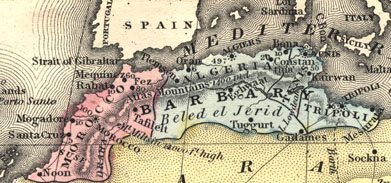
African colonizers transferred feminist values to Iberia and these values are evident in the fifteenth-century marriage contract of Isabel Trastamara, Queen of Castile, and Fernando, King of Aragon and Sicily, as this marriage contract had more in common with Berber practices than it did with the Germanic system undergirding Aragonese law. Africans colonized Iberia in several waves: the Almoravid and Almohad dynasties, the Berber invasion led by Tarik Ibn Ziyad in 711 C.E., the Barca invasion led by Hannibal and contested by Roman general Scipio, and, according to research by Spanish geneticists, waves of migration dating to the desiccation of the Sahara. The Spanish Trastamara dynasty to which Isabel and Fernando belonged arose in an ancient world trade system encompassing the basin between the Atlas and the Pyrenees mountains wherein matrilineage matters consistently across time, language, religion and regime. While twentieth-century scholars emphasized the Germanic historical contributions in Iberia, reflecting European colonial and racial priorities, results of genetic anthropological comparative studies require historians to revisit Iberian history and account for the African component in the peninsular cultural equation as it occurred, especially with respect to women’s roles as reproducers of civilization and humans, even when that evidence contradicts history as some would like it to have happened.
Recent genetic studies of Iberians and Saharan Berbers endorse research trajectories of scholars, inspired by Diop and Bernal, who explore the African diaspora as a narrative greater than the Atlantic slave trade. This broader perspective was recently argued, for example, in 2006 by Gwyn Campbell at the Goa Conference on the African Diaspora in Asia when he proclaimed in the keynote address that "not all Africans came to Asia as slaves; not all slaves were Africans." There is more to the African presence in world history than what Campbell calls the "victim diaspora" narrative. This latter narrative, one which rightly vivifies the trauma of the Middle Passage and slavery, constrains some scholars to present African diaspora cultures as universally and eternally marginalized and subaltern, whether in India with the Siddhi population or in the United States even though a measurable free African-American population owned property, both real and human. I believe that the "victim diaspora" narrative, when taught exclusively, serves as a self-replicating, ideological repressive structure that feeds a malaise among African diaspora youth. As Paul Tiyambe Zeleza wrote, "the challenge is to build up the histories of the other diasporas [intra-African, Indian Ocean and Mediterranean], and to develop comparative methodologies that will yield a more comprehensive and complex picture of the global dimensions of the African diasporas over the last millennia." I urge additional caution in restricting our research to comparative methodologies lest we generate texts that are unintentionally imbued with a dominant/subordinate or normal/pathological power structure. I believe that the research path plotted by the genetic evidence leads to syncretism at cultural intersections which can greatly enhance our knowledge gained by comparative histories.
This paper is an attempt at syncretic history, exploring the fusion of cultural practices with respect to gender and power as found in the fifteenth-century marriage contract between Isabel of Castile and Fernando of Aragon. As supported by genetic evidence, the Trastamaras’ kingdom was situated on a peninsula that was in some aspects, from prehistoric time to the sixteenth century and continues to be, the northern reach of a coherent cultural and geographical zone, a valley bounded by the Cantabrian, Pyrenees, Alps, Rif, and Atlas mountain ranges. While some historical documents written by Near Eastern or West European patriarchal imperialists over the centuries suggest absolute cultural conquest of the zone, the marriage contract of Isabel and Fernando reveals that some forms of Western male dominance never reached deeply enough in the Berber/Iberian Atlantic world to extinguish the matrifocal gender system that predated it.
In this essay, I review the genetic evidence that calls for a syncretic history of Spain. Then I review some of the historiography of the Christian expansion on the peninsula. This is followed by a presentation of the Berber legal system that arrived in Iberia with the Islamic conquest and the Visigothic legal system which dominated in Aragon. Finally, I examine evidence of cultural fusion of African Berber customs in a Germanic zone, by visiting the domestic practices of Isabel I and her brother, Enrique IV, and by analyzing Isabel and Fernando's marriage contract.
[Read this full article here in Adobe .pdf format >>>].
[Return to table of contents]
Tikettin yat familia/Once upon a Family:
Family Origins and Slave Histories in Southern Morocco
By Madia Thomson
Dissertation Abstract: Dr. Thomson received her Ph.D. from the Department of History at Boston University in 2005. Her dissertation, entitled "The Historical Present: Modernization, Slavery, and the Transformation of Social Hierarchy in Southwestern Morocco, 1912-1956," addressed aspects of modernization and social change in twentieth-century Morocco through the lens of slavery. Her dissertation argues that the actions of slaves encouraged changes in the institution of slavery that, when combined with the forces of economic modernization, reshaped earlier social configurations. Patron-client relations in Moroccan society mirrored the power structures of the institution of slavery; changes in the institution therefore reflected changes in the political economy of Morocco.
Using Arabic, Berber, and French sources, the study first examined life in Berber-speaking Tazerwalt (southwestern Morocco) where the saint Sidi Ahmed ou Moussa established a zawiya, religious center, in the sixteenth century. As elsewhere during this period, the region consisted of social groups with varying social power: shorfa, the Prophet Muhammed's descendants; igourramen, saints' descendants; imazighen, white Berbers; issouqin, black Berbers; isemgan, black slaves; udain, Jews. The religious heritage attributed to the shorfa and igourramen assured high social standing. Lacking similar standing, imazighen, isemgan, and issouqin defined themselves in terms of economic function, family origins, and physiognomy; differences of religion distinguished them from udain. Using this social organization as a baseline, the dissertation shows how a combination of government policies and human agency under the Protectorate promoted both domestic and international migration amongst non-elites, eliminating slavery and giving Moroccan society its current fluid, increasingly urban social configuration.
The following paper, derived from that larger study, presents an analysis of identity formation among the descendants of formerly enslaved individuals in Morocco.
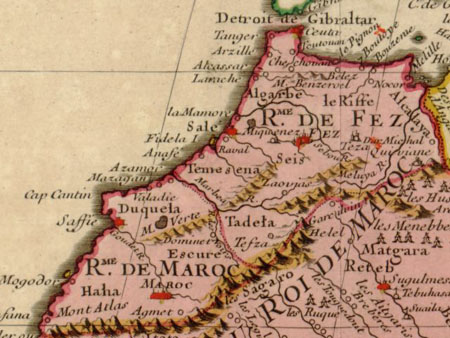
Driving along the winding dirt road leading to Iligh from the Zawiya of Ahmed ou Moussa, one would hardly guess that the dusty village was once the capital of a wealthy principality. Trans-Saharan trade in cloth and ostrich feathers, a popular nineteenth-century fashion accessory, the key to its prosperity, ended early in this century, leaving the village and the surrounding region of Tazerwalt to face a modernizing economy without the major source of its income. Ruined walls are all that remain of its physical grandeur, but traces of its former social and economic power are visible in the culture and color of its modern inhabitants, some of whom are descendants of slaves brought from the Sahara and Sahel. This essay examines how descendants of slaves account for their origins by narrating family histories which deal with the recent past of slavery. I will argue that the family histories recounted by descendants of slaves reflect social and economic imperatives of contemporary life in the village by stressing origins in Iligh, minimizing historical connections to other parts of the Sahara and the Sahel. Telling one's family history in a way that minimizes origins outside the village enable descendants of slaves to affirm belonging in the local community and receive the social and material goods that go with this status.
[Read this full article here in Adobe .pdf format >>>].
[Return to table of contents]
American Demands, African Treasures, Mixed Possibilities
By Daniel McNeil
Abstract: In the 1990s, many Americans sought to cast themselves as heroic defenders of the liberal arts by condemning Afrocentricity. This paper reveals how many such profiteers and schemers were invested in Eurocentricity, but it also critiques Molefi Asante -- the man who coined the phrase "Afrocentricity" -- and points out his reliance on AfroAmericocentric norms. This paper was originally published in the Canadian Review of American Studies, 36(2): 181-93 (2006), and is republished here by the author, in slightly modified form, with the Review's generous permission.
The usual response to a racist attack has been for the victim to reply in kind against the race of his opponent -- not to question the dogma of racism (Gosset 410).
In Bad Faith and Anti-Black Racism, Lewis Gordon devised an intriguing exchange between a white writer and a Black writer. In the dialogue the white writer gets rather offended that he is "shut out" by Black writers who choose to write to Black people, letting Gordon's Black writer respond with an eloquent version of "kiss my ass."
Since white writers have more power in the dissemination and presentation of knowledge, I wonder why you even bother with me? Wouldn’t your self-righteousness be more productive elsewhere? You remind me of those folks who waste their time attacking afrocentricity -- as if afrocentricity seriously has the political organizing elements of Wretched of the Earth or Black Jacobins (120).
Gordon's Black writer might have had a similar response to Henry Louis Gates Jr. -- America's "most esteemed black scholar" according to journalists in the mainstream media (Hitchens) -- who talked about planning a series of debates with Molefi Asante, the head of Temple University's Afrocentric camp. Yet critiques of Afrocentricity have not only come from African Americans worried about (self-) segregation, as Gates Jr. is, or from white scholars of ancient cultures tired of students asking them if Cleopatra was Black. Paul Gilroy, a Black British intellectual, engaged with Afrocentricity in order to locate its Americo-centrism and describe a reactionary Other that reinforced his commitment to "planetary humanism." According to Gilroy, Afrocentricity relies on "a discourse of racial particularity that does not translate very easily to other circumstances and . . . expresses a distinctively American understanding of ethnicity, kinship and cultural difference" ("Between"). And, although Asante has denounced Gilroy's Black Atlantic: Modernity and Double Consciousness as "mulatto consciousness" parading as "African consciousness" (Afrocentric Idea 178; "Afrocentricity"), such ad hominem attacks only work to justify Gilroy's suspicion of the "dualistic thinking that risks attempting to reduce the world to a set of theoretical categories and is such a recurrent feature of the drive towards simplicity which so often unravels both anti-racism and internationalism" ("Nationalism" 68). While sharing Gilroy's desire to challenge Asante's ruthless use of binary oppositions, this paper also heeds the advice of Gordon’s Black writer and argues that many critics of Afrocentricity ignored Fanon's commitment to honest intellectual work when they acted like profiteers and schemers during the early days of state-sanctioned multiculturalism in the United States during the early 1990s.
[Read this full article here in Adobe .pdf format >>>].
[Return to table of contents]
Slave Routes in Western Tanzania:
A Preliminary Report on Survey in Tabora and Ujiji.
By Sarah Croucher and Stephanie Wynne-Jones[1]
The following report is a brief introduction to reconnaissance survey work carried out in Western Tanzania in July 2006 to investigate caravan routes that ran from the East African coast inland as far as the Congo during the 18th and 19th centuries. These routes were tied to the trading of captive Africans from inland areas to the Indian Ocean coast. When they reached the coast, enslaved individuals were either kept to work on local Arab-run plantations, or traded out into the Indian Ocean. Although it has proved difficult to quantify the number of slaves being traded from this region during the 18th and 19th centuries, the African Diaspora in the Indian Ocean region has been described as "one of the most neglected aspects of the global diaspora of African peoples" (Alpers, 2000: 84). The reconnaissance survey in the areas of Ujiji and Tabora (see Figure 1 for a map of the trade routes in the area) had the aim of locating sites related to the caravan trade along which these slaves were traded. In addition it aimed to locate earlier sites of settlement in the region, and thus contextualising later colonial changes within the longer time scale of history.
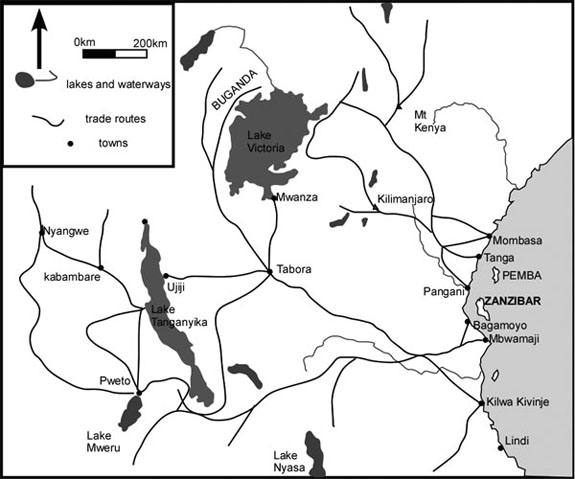 | | Figure 1: Map showing major caravan routes in 19th century East Africa after Sheriff (1987: 191). |
The East African caravan trade of the 18th and 19th centuries linked the coast of present-day Kenya and Tanzania as far as 1,500 miles inland to the Congo. It has been argued to have caused major changes in the economies, politics and societies and cultures of the communities through which it passed (Rockel, 2000a: 769). In the area around the modern town of Ujiji, on the shore of lake Tanganyika, these changes were experienced by the local Watongwe population as well as migrants who arrived in the area to trade, drawn from Arabia, the East African coast, and from central Tanzania. In Tabora, another urban centre that developed as a result of trade routes, the local population consisted of Nyamwezi groups, who similarly found their lives intertwined with migrants moving along these caravan networks. Societies living along the 19th century caravan routes are recognised as having gone through massive upheavals and changes at this time, with the world in which they were living becoming "immensely larger" (Iliffe, 1979: 1), as a commercial economy developed through large swathes of Tanzania. A partially monetized economy, merchant capital and wage labour became increasingly a part of the lives of local groups along these routes (Rockel, 2000a: 769) as trade grew in ivory, slaves and weapons (Rockell, 2000b: 173) and other trade goods such as cloth and ceramics (Gray, 1962: 108; Iliffe, 1979: 19).
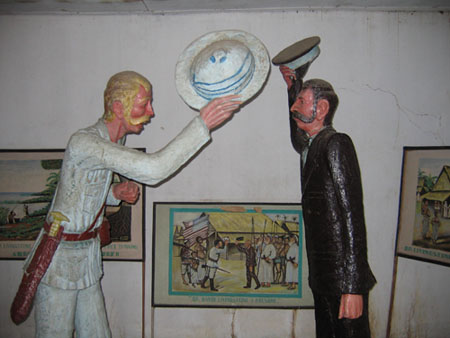 | | Figure 2: Papier maché statue showing journalist Henry Morton Stanley meeting missionary Dr David Livingstone at Ujiji, on the shores of Lake Tanganyika in 1871. This was the moment at which the famous words "Dr Livingstone, I presume" are thought to have been uttered by Stanley. Today, these statues and some paintings of this period, form the only museum objects in the Ujiji museum. |
Despite the fact that only a small amount of historical work, and virtually no archaeology, has been done in this region, what is clear is that thousands of slaves were forcefully migrated from these areas as part of the increasing capitalist trade of Omani colonialism in East Africa during the 18th and 19th centuries. This means that the African Diaspora formed part of the daily social reality for residents in these areas at this time. Patchy historical records for the period, mostly recorded through the descriptions of the first European missionaries and explorers to travel to the area. Both Tabora and Ujiji have famous Stanley and Livingstone connections. A hangover of the British colonial era in Tanganyika is the memorialisation of these sites, to the exclusion of any form of local African heritage. The Livingstone tembe (the house where he lived in the 19th century) is open for visitors in Tabora, and a memorial to the meeting of Livingstone and Stanley has existed in Ujiji in some form since 1916 (Grant, 1932: 318). However, these sites simply memorialise an Anglo-American version of history, whereby Livingstone was instrumental in the ending of slavery in the area (see Figure 2).
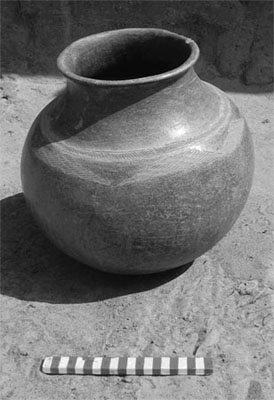 | | Figure 3: Contemporary pot, Tabora. |
The reconnaissance survey project undertaken in July 2006 however, had very different aims. Rather than simply recording the physical remains of sites known by European travellers, we wanted to understand how this trade route of the African Diaspora had effected local populations, and how we might see changing identities in everyday domestic contexts along these routes. This was very much intended as a preliminary season of fieldwork, before targeting areas for closer, more systematic investigations in 2007. Nineteenth century sites, which would have been contemporaneous with the caravan trade, proved easy to locate in both the Tabora and Ujiji areas, with 20 sites recorded in total.
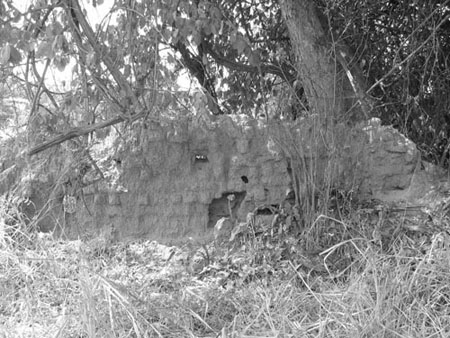 | | Figure 4: Remains of mud-brick wall, Maswas Fort. |
In the Tabora area, sites located close to the contemporary urban centre of Tabora proved easy to locate. These included a wide scatter of artefacts around the area of the Livingstone tembe, including European ceramics. The majority of artefacts at all sites recorded here were local ceramics, although European imported spongewares, dating to the late 19th century, were not uncommon. Large grinding stones were also found at several sites, and these, along with palm trees (which were introduced in the 19th century to this area), seemed to serve as the most obvious indicators of past human habitation. The most common local ceramic decoration appeared to be variations of incised triangles (similar to that observed on contemporary ceramics, as in Figure 3). Such decoration is in marked contrast to that found on the East African coast in the 19th century, and appears to reflect a separate local trajectory of inland forms and decorations on local ceramics. At present however, our artefact analysis is only at a preliminary stage, and it is not possible to speculate about the possible social meanings of these ceramics.
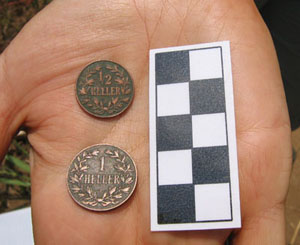 | | Figure 5: Coins from the German colonial period (dated 1906 on reverse). |
Sites in various locales near the present towns of Ujiji and Kigoma were similarly easy to locate. Of particular importance were contrasting sites around the village of Ujiji, and a site which appears to relate to an indigenous trading settlement, south of Ujiji along the lakeshore. Excavations are planned for both of these areas in 2007. Ujiji is now eclipsed by the nearby port of Kigoma, but was the major caravan terminus on the shores of Lake Tanganyika during the 19th century, for traders coming both from the coast and destinations across the lake in the Congo. This was the major 'Arab' immigrant settlement in the region, and the results from excavations here will be representative of daily life in a 19th century inland urban settlement, nominally ruled by Omani colonial elites in Zanzibar. Oral histories recorded in July 2006 recounted that the area had been inhabited by some of the local indigenous population who had settled in the town (mostly converting to Islam) and Arab, Indian and other traders who migrated from the coast; all of these town residents were said to have lived in square houses and to have made extensive use of imported material culture, as well as dressing in coastal styles. Contrasting with this is the site of Maswas' Fort (see Figures 4 and 5), today marked only by a series of degrading mud-brick walls. Oral histories testify that this was the settlement of an indigenous Watongwe leader (Maswas), who established a stronghold here with both round and square houses, did not convert to Islam or Christianity, but who also engaged in trading activities with Arab caravan leaders. The site appears to have been continuously occupied into the early 20th century, and finds included coins from the German colonial period.
Notes.
[1]. Dr. Sarah Croucher is affiliated with the University of Manchester, and Dr. Stephanie Wynne-Jones is with the British Institute in Eastern Africa.
References
Alpers, E.A. 2000.
Recollecting Africa: Diasporic Memory in the Indian Ocean World. African Studies Review 43(1), 83-99.
Grant, Captain C. H. B. 1932.
The Livingstone-Stanley Memorials in Africa. The Geographical Journal 79(4): 318-319.
Gray, J. 1962.
History of Zanzibar: From the Middle Ages to 1856. Oxford: Oxford University Press.
Iliffe, J. 1979.
A Modern History of Tanganyika. Cambridge: Cambridge University Press.
Rockel, S. 2000a.
Enterprising partners: Caravan women in nineteenth century Tanzania. Canadian Journal of African Studies 34(3): 748-778.
Rockel, S. 2000b.
'A nation of porters': The Nyamwezi and the labour market in nineteenth-century Tanzania. Journal of African History 41: 173-95.
[Return to table of contents]
From Huts to Barracóns in Nineteenth-Century Cuba Plantations
By Lisette Roura Alvarez
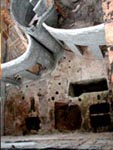
Lisette Roura Alvarez is a specialist in historical archeology in the Archeology Division, Office of the Historian, City of Havana, Cuba. She has prepared a report and analysis of archaeological and historical investigations of the houses of enslaved laborers in nineteenth century sites in Cuba. Her report includes the coffee plantation site of Santa Ana de Viajacas in Madruga, Cuba. Ms. Alvarez's analysis examines differences across sites in Cuba between residential compounds of smaller structures and the development of larger-scale, walled "barracón" compounds. The increase in such larger-scale housing investments appears to correlate with the period following the rebellion on Saint Domingue (Haiti) in the 1790s and the corresponding intensification of Spanish colonial efforts in sugar and coffee production plantations in Cuba. More information on her work can be obtained by contacting her at roura@arqueologia.ohch.cu. The Archaeology Division of the City of Havana also maintains a web site, available at http://www.ohch.cu/boletin-arqueologico/.
[Return to table of contents]
Dissertation Abstract:
The Dynamics of Industry as Seen from Van Winkle's Mill, Arkansas
By Alicia B. Valentino
Ph.D. Dissertation, Department of Anthropology, University of Arkansas, Fayettsville. 2006.
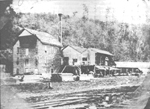
Van Winkle's mill in Benton County, Arkansas, was home to the most productive and powerful 19th-century mill in the Arkansas Ozarks. Today only machinery platforms and a flywheel trench remain. Archaeological investigation in Van Hollow, the locale of this mill, has taken place since 1997, yet the nature of industrial technology and the layout of the saw- and gristmill remain neglected. This study examines the industrial archaeology of this mill complex within the context of its social and cultural framework. The result illustrates that despite being on the frontier, daily operations were integrated with local, regional, and national institutions.
The nature of this interpretation is apparent in terms of the labor force, where enslaved African-Americans and free whites worked side-by-side in the mill facility. Archaeology of the blacksmith shop demonstrated the partial adoption of new technologies (indicating knowledge of new methods yet the inability to fully implement them) and the layout of the shop. Excavation of the mill complex yielded a determination of the layout of that facility and a comparison of the technology there within national trends.
Of particular importance was the determination that Van Winkle's mill could be supported by solely local demand, yet Van Winkle developed his business to serve the region. Using comparative archaeological studies, least cost models, and friction surface analyses, it became apparent that Van Winkle had little interest in the local population and manipulated the development of transportation networks and his satellite mills to distribute his products in the four-county area and to neighboring states. Finally, using census records, a context was developed for the Arkansas Ozarks to gauge the level of technological development in the Hollow. This analysis demonstrated how the regional impact of Van Winkle's mill was a combination of high rates of production, power, and value of products. The result is an archaeological and historical study that is anthropologically oriented in its attention to the human element of industry. It is a unified view of the industrial operations in Van Hollow and the Arkansas Ozarks with a dynamic and balanced interpretation of industrialization and development.
This dissertation can be downloaded in its entirety, or by chapter, at the Van Winkle’s Mill web site, http://www.projectpast.org/vanwinkle/index.html.
[Return to table of contents]
Dissertation Abstract:
Strategic Consumption: Archaeological Evidence
for Costly Signaling among Enslaved Men and Women
in the Eighteenth-Century Chesapeake
By Jillian E. Galle
Ph.D. Dissertation, Department of Anthropology, University of Virginia, Charlottesville. May, 2006.
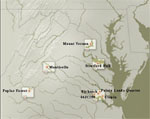
This broadly comparative study explores the complex social, economic, and ecological dynamics that facilitated the participation of enslaved African Americans in the eighteenth-century Consumer Revolution. The application of signaling theory to archaeological data from 19 slave quarter sites in the greater Chesapeake region of Virginia underpins this analysis. This study demonstrates that throughout the eighteenth century slave consumption of costly imported goods was influenced by a number of contextual variables. The extent to which increasing urban populations, economic and agricultural diversification, and a slave quarter’s proximity to the owner’s house shaped consumption are modeled using multiple regression. The significant positive relationship of costly goods with agricultural diversification and the growth of urban centers suggests that a slave’s ability to consume such items was linked closely to the increasingly competitive social and economic environment within the eighteenth-century Chesapeake.
The data used in this study indicate that four main signaling strategies were at work in the Chesapeake. Since metal buttons are associated primarily with eighteenth-century male garments, quarters with high button discard and low refined ceramic discard suggest the persistence of single-sex residences for young adult men throughout the eighteenth and into the early-nineteenth centuries. Households that almost exclusively invested in refined ceramics and those that were able to consume similarly high amounts of both buttons and refined ceramics may point to kin-based households anchored by women and men who worked extraordinarily hard to establish a foot-hold in a culture and economic system that sought to exclude them in every way. These households may have included few to no children, thereby enabling their members to translate their labor more easily into imported consumables. This study uncovers the complex processes that drove the consumption of costly goods and demonstrates that they likely functioned as essential components of localized and regional signaling systems that provided social and economic benefits to the most competitive and successful signalers.
[Return to table of contents]
Seventy Years Ago in Jamaica
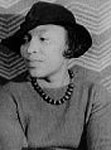
Zora Neale Hurston traveled and conducted field work in Jamaica and Haiti in the late months of 1936. She wrote Their Eyes Were Watching God in a brisk seven weeks, and collected material that she would later present in Tell My Horse and other publications. In addition to recording highly valuable ethnographic and historical data, she was a truly gifted writer. Here is a passage from Tell My Horse, originally published in 1938 (Harper & Row edition, 1990, pp. 40-41), describing part of a funeral ceremony in Jamaica:
"This man had died in the hospital some distance from home. He was as poor in death as he had been in life. He had walked barefooted all his days so now there would be no hearse, no car, no cart -- not even a donkey to move this wretched clay. Well then, a rude stretcher was made out of a sheet and two bamboo poles and men set out on foot to bring the body home. There are always more men than donkeys."
"According to custom, several people from the district went along with the body-bearers to sing along the road with the body. The rest of the district were to meet them halfway. It is a rigid rule that the whole district must participate in case of death. All kinds of bad feelings are suspended for the time being so that they sing together with the dead. . . ."
"The bearers and these folks had been gone a long time when we other set out to meet them half way. Two or three naked lights or flambeaux were among us but nobody felt the need of them. A little cement bridge had been agreed upon as the halfway mark, so we halted there to wait. Perhaps it seemed longer than it really was because people saved up the entertainment in them for the time when the body would arrive. So we were a sort of sightless, soundless, shapeless, stillness there in the dark, wishing for life."
"At last a way-off whisper began to put on flesh. In the space of a dozen breaths the keening harmony was lapping at our ears. Somebody among us struck matches and our naked lights flared. The shapeless crowd-mass became individuals. A hum seemed to rise from the ground around us and became singing in answer to the coming singers and in welcome to the dead."
"The corpse might have been an African monarch on safari, the way he came borne in his hammock. The two crowds became one. Fresh shoulders eagerly took up the burden and all voices agreed to sing on one song. Then there was a jumbled motion that finally straightened out into some sort of marching order with singing. Harmony rained down on sea and shore. The mountains of St. Thomas heaved up in the moonlessness; the smoking flambeaux splashed the walking herd; bare feet trod the road in soundless rhythm and the dead man rode like a Pharaoh -- his rags and wretchedness gilded in glory."
[Return to table of contents]
International Day for the Abolition of Slavery
By U.N. Secretary-General
Statement posted online by the United Nations at: http://www.un.org/.
United Nations Secretary-General
Department of Public Information
News and Media Division, New York.
SG/SM/10745, OBV/594.
November 17, 2006.
Contemporary Forms of Slavery Flourishing, says Secretary-General.
The following is the message by the UN Secretary-General Kofi Annan on the International Day for the Abolition of Slavery:
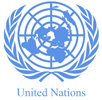
On 25 March 2007, the world will mark the two-hundredth anniversary of the abolition of the slave trade in the British colonies. This landmark will be a powerful reminder of centuries of struggle and progress in combating slavery -- but also of the fact that we still have not managed to eliminate it completely. Contemporary forms of slavery -- from bonded labour to human trafficking -- are flourishing as a result of discrimination, social exclusion, and vulnerability exacerbated by poverty. Because of our failure to alleviate poverty, defend the human rights of all, and address impunity effectively, potential victims are unable to protect themselves against exploitation and abuse.
The movement against slavery was the first campaign to bring together the international community in the struggle against gross human rights violations. It demonstrated how effective the mobilization of public opinion can be, when the cause is compelling enough, and leaves no room for compromise.
Today, we must carry on the struggle. I call on States to ratify international instruments against slavery, and to cooperate fully with all relevant international human rights mechanisms. I urge on them to make greater use of existing tools, such as the Principles and Guidelines on Human Rights and Human Trafficking. I appeal to them to contribute generously to the United Nations Voluntary Fund on Contemporary Forms of Slavery, so we can continue providing assistance to victims. I implore them to step up measures to eliminate the entrenched poverty, which continues to render our fellow human beings vulnerable to enslavement. And I encourage people everywhere to hold their Governments accountable.
On this International Day, let us pledge to draw on the lessons of history to free our fellow human beings from slavery.
[Return to table of contents]
Caribbean Grave Site Illuminates Slavery
By Mat Probasco
November 5, 2006
Article posted online by the Associated Press at: http://abcnews.go.com/
Copyright 2006 Associated Press.
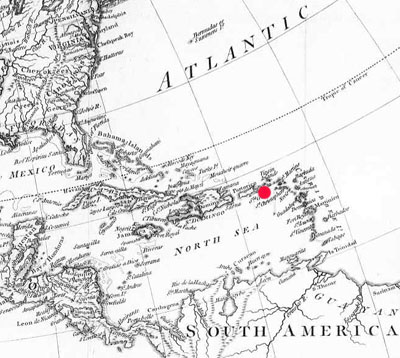
Caribbean Burial Ground Could Shed Strong Light on the Life and Death of Slaves
Charlotte Amalie, U.S. Virgin Islands -- A paper trail documents their lives as human property, from their passage across the Atlantic to their sale as slaves for sugar plantations. Now a newly discovered burial ground promises to shed extensive new light on the lives and deaths of Africans in the Caribbean.
Researchers from Denmark and the U.S. Virgin Islands want to unearth up to 50 skeletons next year, hoping to learn about their diet, illnesses and causes of death, and thus broaden knowledge of slave life in the one-time Danish colony.
Descendants of slaves could discover ancestors through DNA tests. At public meetings, islanders have also embraced the excavations as a way for Europeans to recognize their historic role in the slave trade and perhaps to make new amends.
Most slaves in the Americas were buried in unmarked graves, and studies of slave graveyards "are rarer than hen's teeth. The science that will come out of it will just be extraordinary," said David Brewer, an archaeologist with the U.S. Virgin Islands government and one of the scientists planning to unearth some tombs in November to assess their condition before the project starts in March.
The slaves are buried in shallow graves beneath mounds of stones and conch shells, some marked by small, illegible headstones. They were found this year on a private 300-acre estate on St. Croix, the largest island.
Details have been withheld while researchers negotiate access to the property, said Brewer, who refused to identify the owner or the exact location of the graveyard.
The scientists will examine teeth and bones and conduct chemical analysis in a mobile laboratory. Brewer stressed that the bones will be disturbed as little as possible and reburied exactly as they were found.
One fingernail-sized shaving will be taken from each skeleton for a database of African DNA that could reveal links to other slave populations.
"This is the closest we can possibly get to telling the story of their lives as they knew it," said Pia Bennike, an anthropologist leading the team from the University of Copenhagen.
More than 100,000 enslaved Africans, mostly from what is now Ghana, arrived in the Danish West Indies from 1617 to 1807, according to Myron Jackson, director of the U.S. Virgin Islands' historical preservation office. Many were sold at slave markets and shipped to the American colonies while thousands remained as the property of Danish colonists.
From the time they were big enough to work, slaves cut sugar cane and picked cotton, tobacco and sweet potatoes in the Caribbean heat, Jackson said. When severe drought hit in 1725 and 1733, some plantation owners starved their work force rather than pay for food to be shipped to the islands.
David Brion Davis, a Yale University historian, notes that Caribbean slaves died much faster than those on the mainland and had a lower birthrate because of the harsh environment and labor conditions.
"Sugar production was a very, very taxing almost lethal kind of occupation," he said, noting that many lost limbs in machines.
Slaves who plotted revolt, tried to escape or threatened a white man were punished by 150 lashes, brandings on their forehead, or having a leg or ear chopped off. Others were hanged or tortured to death.
The Danes outlawed slavery in 1848. The United States bought the three-island territory from Denmark in 1917.
An island group is hoping the project will boost its case for reparations from Denmark.
No demands for compensation have ever been made. But educating Europeans about their role in the trans-Atlantic slave trade will likely lead to more Danish investment and possible payments, said Shelley Moorhead, president of the African-Caribbean Reparations and Resettlement Alliance, based in St. Croix.
Historian Davis said he is particularly interested in whether the genetic testing shows how often blacks and whites interbred.
He said the study holds great potential. "There are probably gaps we don't even know about that will be filled in."
[Return to table of contents]
Libraries in the Sand Reveal Africa's Academic Past
By Nick Tattersall
November 10, 2006
Article posted online by the Reuters at: http://www.reuters.com
Copyright 2006 Reuters.
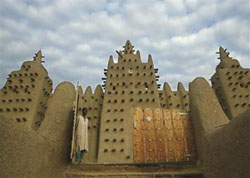
Timbuktu, Mali (Reuters) -- Researchers in Timbuktu are fighting to preserve tens of thousands of ancient texts which they say prove Africa had a written history at least as old as the European Renaissance.
Private and public libraries in the fabled Saharan town in Mali have already collected 150,000 brittle manuscripts, some of them from the 13th century, and local historians believe many more lie buried under the sand.
The texts were stashed under mud homes and in desert caves by proud Malian families whose successive generations feared they would be stolen by Moroccan invaders, European explorers and then French colonialists.
Written in ornate calligraphy, some were used to teach astrology or mathematics, while others tell tales of social and business life in Timbuktu during its "Golden Age," when it was a seat of learning in the 16th century.
"These manuscripts are about all the fields of human knowledge: law, the sciences, medicine," said Galla Dicko, director of the Ahmed Baba Institute, a library housing 25,000 of the texts.
"Here is a political tract," he said, pointing to a script in a glass cabinet, somewhat dog-eared and chewed by termites. "A letter on good governance, a warning to intellectuals not to be corrupted by the power of politicians."
Bookshelves on the wall behind him contain a volume on maths and a guide to Andalusian music as well as love stories and correspondence between traders plying the trans-Saharan caravan routes.
Timbuktu's leading families have only recently started to give up what they see as ancestral heirlooms. They are being persuaded by local officials that the manuscripts should be part of the community's shared culture.
"It is through these writings that we can really know our place in history," said Abdramane Ben Essayouti, Imam of Timbuktu's oldest mosque, Djingarei-ber, built from mud bricks and wood in 1325.
Heat, Dust and Termites
Experts believe the 150,000 texts collected so far are just a fraction of what lies hidden under centuries of dust behind the ornate wooden doors of Timbuktu's mud-brick homes.
"This is just 10 percent of what we have. We think we have more than a million buried here," said Ali Ould Sidi, a government official responsible for managing the town's World Heritage Sites.
Some academics say the texts will force the West to accept Africa has an intellectual history as old as its own. Others draw comparisons with the discovery of the Dead Sea Scrolls.
But as the fame of the manuscripts spreads, conservationists fear those that have survived centuries of termites and extreme heat will be sold to tourists at extortionate prices or illegally trafficked out of the country.
South Africa is spearheading "Operation Timbuktu" to protect the texts, funding a new library for the Ahmed Baba Institute, named after a Timbuktu-born contemporary of William Shakespeare.
The United States and Norway are helping with the preservation of the manuscripts, which South African President Thabo Mbeki has said will "restore the self respect, the pride, honor and dignity of the people of Africa."
The people of Timbuktu, whose universities were attended by 25,000 scholars in the 16th century but whose languid pace of life has been left behind by modernity, have similar hopes.
"The nations formed a single line and Timbuktu was at the head. But one day, God did an about-turn and Timbuktu found itself at the back," a local proverb goes.
"Perhaps one day God will do another about-turn so that Timbuktu can retake its rightful place," it adds.
Related Article and Exhibit
The December 2006 issue of the Smithsonian Magazine includes an article entitled The Treasures of Timbuktu, written by Joshua Hammer, with photographs by Alyssa Banta. The article is available online at http://www.smithsonianmagazine.org/issues/2006/december/timbuktu.php.
In addition, the Library of Congress presents an online exhibit entitled Ancient Manuscripts from the Desert Libraries of Timbuktu. The introduction states: "Dating from the 16th to the 18th centuries, the ancient manuscripts presented in this exhibition cover every aspect of human endeavor and are indicative of the high level of civilization attained by West Africans during the Middle Ages." The exhibit is available at http://www.loc.gov/exhibits/mali/.
[Return to table of contents]
In Search of Skeletons
By Elizabeth Redden
November 27, 2006
Article posted online by the Inside Higher Ed at: http://www.insidehighered.com
Copyright 2006 Inside Higher Ed.
Brown University's October report elucidating the institution's early ties to slavery has stepped up the pressure on other colleges to delve deeply into their own pasts and fully acknowledge their institutional links to slavery, Nazi Germany and other disgraced ideas.
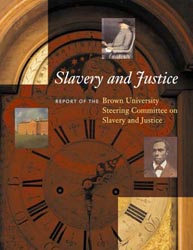
Read the report by
Brown University |
Colleges are accustomed to taking more contemporary moral stances, whether by divesting from Sudan or "kicking Coke" to protest alleged labor and environmental practices. But a new model for social responsibility -- based on a careful look at the past -- has gained a foothold at the nation's elite colleges.
Following the release of Brown's report, Alfred L. Brophy, author of Reparations: Pro and Con (Oxford, 2006) and a law professor at the University of Alabama, predicted that other Ivies would quickly follow suit: First to enter the arena, Brophy predicted, would be Yale University, where graduate students initiated their own inquiry into institutional ties to slavery in 2001, determining, among other things, that many of Yale’s residential colleges had been named for slave owners and pro-slavery leaders. Harvard University, with its famous history faculty and ties both to slavery and the anti-slavery movement, would follow closely, with Princeton University, the Ivy that in the era before desegregation catered to Southerners much more so than its New England peers, not far behind. [read more >>>].
[Return to table of contents]
Museum Developments in 2006
National Slavery Museum Fundraising Project

The United States National Slavery Museum (USNSM), planned for construction in Fredericksburg, Virginia, is "asking Americans to contribute $8.00 or more to the construction of the only museum in our nation devoted exclusively to telling the story of American slavery; 8 is the shape both of shackles (the symbol of slavery) and, if turned on its side, of infinite freedom; 8 is an amount that allows every American to be a part of this incredible project; 8 will help remove shackles that have divided our nation and replace them with a new symbol for a united America." Additional news and information on development efforts for the USNSM are available on the Museum's web site, at: http://www.usnationalslaverymuseum.org.
Location Selected for Planned
National Museum of African American History and Culture
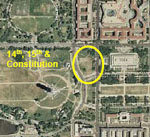
Earlier in 2006, the Smithsonian Institute's Board of Regents, the governing body of the Institution, announced the location for the new National Museum of African American History and Culture. The Regents
selected the area of land known as the "Monument site," bounded by Constitution Avenue, Madison Drive, and 14th and 15th Streets N.W., in Washington, D.C. The site is adjacent to the Washington Monument and across the street from the National Museum of American History. Additional news and information on development efforts for this Museum are available on the Smithsonian web site, at: http://nmaahc.si.edu/.
Smithsonian "Exclusive Access" Controversy
The National Coalition for History (NCH) reports in its November, 2006 newsletter that controversy continues over the Smithsonian Institution's agreement of exclusive access by the Showtime entertainment company to the Institute's collections for the purposes of creating documentaries. Such an arrangement would presumably impact access to ethnographic and historical collections on African, African-American, and African diaspora cultures. The NCH, available online at http://www.h-net.org/~nch/, reports:
"In the wake of the recent controversy over the Smithsonian Institution's (SI) exclusive and confidential agreement with Showtime, and recognizing that a new Congress presents new opportunities to derail the controversial agreement, a group of concerned historians, scholars, filmmakers, and others recently sent a letter to Congress demanding action."
"The Business Ventures unit of the Smithsonian Institution has been under scrutiny for some time now regarding accounting and management issues. However the contract entered between the SI and Showtime dramatically increased public criticism. The letter to relevant Congressional appropriations and oversight committees notes that the Smithsonian Institution has been under attack by scholars and film makers since entering into a controversial contract that grants the Showtime Network certain exclusive rights to the Institution's staff, collections, and archives. The letter states that while the details of the contract are unknown, it has been established that it includes a '30-year term, a non-competitive procurement' and that organizations such as PBS and the History Channel (to name but two), are all viewed as 'competitive,' and hence the contract impacts their and other independent film makers potential access to the Smithsonian for programs they wish to produce."
"For months, the Smithsonian has steadfastly refused to release the terms of the contract or address the concerns and criticism to the satisfaction of critics. The letter notes that SI officials have also not responded to questions from the Senate Finance Committee, the House Appropriations Committee or the House Committee on Administration. While Congress has authorized the Government Accountability Office (GAO) to conduct a study, the draft report remains confidential as well."
"The letter calls on Congress to take action and shed light on the Smithsonian Showtime deal. At the very least, the contract 'should be made available to the public and reforms could be instituted that would allow for increased dialogue and consultation with the public before a contract is agreed upon.' With the House and Senate set to convene to discuss bills left to be conferenced, there is an opportunity to amend bills that limit public access to contracts. To view the letter, visit http://public.resource.org/smithsonian_congress.html."
[Return to table of contents]
Syracuse University Archaeological Field School
Elmina, Ghana
July 1-14, 2007.
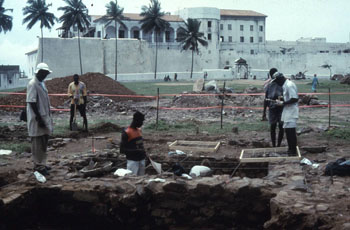
Syracuse University is pleased to announce its historical archaeological field school at the Elmina trading fortress and in the surrounding area of coastal Ghana. Directed by Dr. Christopher DeCorse of Syracuse University, and as part of the on-going Central Region Project, historical archaeological investigations will be conducted into the Atlantic trade and its cultural repercussions and implications in the region. The field school will take place between July 1 and July 14, 2007. No previous archaeological experience is ncessary, and academic credit will be offered through Syracuse University for both undergraduates and graduates. There may be grants available for student support for the field school.
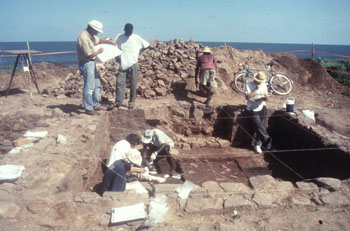
The fortress of Elmina was established as a trading post by the Portuguese in the fifteenth century and played a significant role in trade between West Africa and Europe through the nineteenth century. Throughout its history, merchants from the Portugal, the Netherlands, Denmark, England, France and Brazil, among others, traded manufactured items such as iron, beads, cloth and copper basins for various goods including gold, ivory, enslaved Africans and agricultural products. The fortress (variously called Elmina Castle, Săo Jorge da Mina or Saint George Castle), is a UNESCO World Heritage site and is located on the coast in the town of Elmina. The Central Region Project has been conducting archaeological investigations in the region for over twenty years; past archaeological investigations have concentrated on the fortress grounds themselves, on the immediately surrounding settlements, and on related sites at greater distances from the fortress.
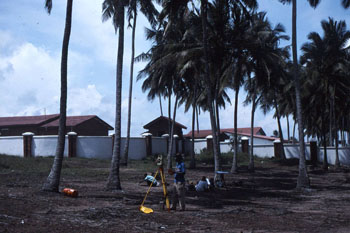
Field school participants will help survey and locate archaeological sites, and excavate and map previously identified sites, as well as spend time in the lab processing artifacts and analyzing field data. Recently a maritime underwater component has been added to the Central Region Project. Qualified participants will have the opportunity to participate in either the terrestrial or maritime components of the project, possibly working in both areas. Due to the high-energy, high-risk diving environment, maritime archaeological involvement will focus primarily on conservation of materials from underwater maritime sites.
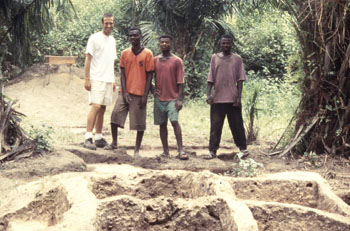
Students will receive 3 credits from Syracuse University for the 2 week field school. It may be possible for students wishing to extend their stay beyond the formal dates of the project to do so for additional credits and fees. Please contact Rachel Horlings [rlhorlin@syr.edu] for questions and an application.
[Return to table of contents]
Field School in Historical Archaeology
Falmouth, Jamaica.
May 23 to June 15, 2007.
Sponsored by the University of Virginia and the Digital Archaeological Archive of Comparative Slavery. Directed by Jillian Galle.
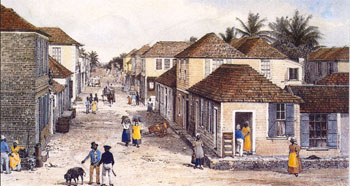
The Falmouth Field School in Historical Archaeology (Anth 382) is a three-week, three-credit program in historical archaeology based in Falmouth, Jamaica. The field school is offered through the University of Virginia’s International Studies Office. Students enrolled in The Falmouth Field School in Historical Archaeology (Anth 382) will conduct archaeological field work at the Stewart Castle slave village, a mid-to-late 18th-century site that has not previously been tested archaeologically. Objectives for the season include a site-wide shovel test pit survey designed to identify temporal and spatial variation within the village. In addition to the survey, several excavation units will be opened to further explore areas discovered during the survey. Students will learn methods for designing archaeological surveys and technologies to record their results, specifically drawing archaeological plans and stratigraphic sections as well as mapping. Each afternoon students will participate in laboratory activities such as artifact washing and identification. Several evenings a week are dedicated to lectures and discussions.
Course readings and lectures will introduce students to archaeological survey and excavation methods, key concepts in the study of 18th-century material culture, and will provide a background in the social history of slavery in the Caribbean. Discussions will focus on the ways in which archaeological data can prompt and address unanswered historical questions related to the evolution of slave societies throughout the Atlantic World.
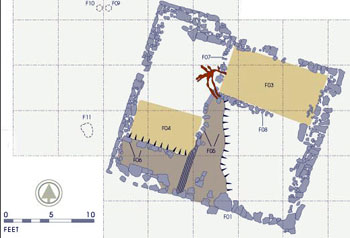
This field school is held in conjunction with The Falmouth Field School in Historic Preservation (Arh 555). Students enrolled in Anth 382 will spend one day a week learning historic preservation techniques with architectural history students from The Falmouth Field School in Historic Preservation (Arh 555).
The Falmouth Field Schools in Historical Archaeology and Historic Preservation will include lectures and field studies with Matthew Webster, Director of Architectural Restoration at Kenmore Plantation, Edward Chappell, Director of Architectural Research at the Colonial Williamsburg Foundation, and Fraser Neiman, Director of Archaeology at Monticello. Guest lecturers will also include historians and archaeologists affiliated with the University of West Indies, Mona, and the Jamaica National Heritage Trust. In Falmouth, the field school is supported by the local efforts of Falmouth Heritage Renewal, a non-profit preservation organization with over a decade of experience in historic preservation in Falmouth.
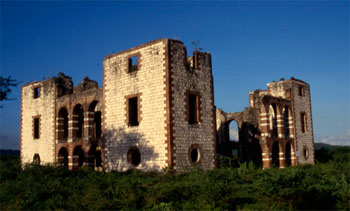
Anthropology 382 Work Schedule: Students work daily Monday-Friday with occasional evening lectures and discussions. Archaeology students will conduct both excavation and laboratory work. Weekends are free time to enjoy Trelawney's beaches and other attractions. Of note are the natural wonders of Glistening Waters, only a ten-minute drive from Falmouth. The markets, beaches and other attractions of both Ocho Rios and Montego Bay are approximately one hour from Falmouth. Falmouth Heritage Renewal does not own any large vehicles, so students will be responsible for their own transportation to these sites in taxis or on Jamaica's public transportation system. Students will have the opportunity to participate in optional field excursions on the two weekends to historic sites across the island, including New Seville, Good Hope Estate, Colbeck Castle, and Spanishtown.
Room and Board Arrangements: Students will be housed in a newly renovated two-story stone building in the heart of downtown Falmouth, Jamaica. Built in the early nineteenth-century as a Masonic lodge, the building served for much of its life as a Baptist manse. The building has a large workshop on the first floor and a number of dormitory-style sleeping quarters on the upper floor. Students should be advised that these accommodations assume multiple students per room in bunk beds with shared bathrooms. Although fans will be provided, these rooms are not air-conditioned. Students will be provided with three meals a day, a breakfast, a packed lunch, and a hot supper. Food will be Jamaican-style and all diets can be accommodated. The building's location allows easy access to local markets and stores where snacks and supplies can be purchased. Room and board are included in the total cost of the field school. Cost per student, which includes tuition, room, and board, is $3100 (in-state) and $3,255 (out-of-state) per student.
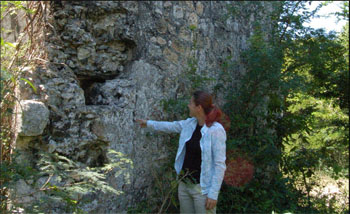
Contact Information: This field school is one component of the much larger archaeological research program, the Digital Archaeological Archive of Comparative Slavery (www.daacs.org). Please contact Jillian Galle (jgalle@monticello.org, 434-984-9873) for more information. Please also see www.daacs.org or www.studyabroad.virginia.edu (Go to "Find a Program" and search under "Jamaica").
Application Information: Applications are due March 15, 2007. Students may apply online at www.studyabroad.virginia.edu (Go to "Find a Program" and search under "Jamaica").
[Return to table of contents]
New Journal

International Journal of African and Black Diaspora Studies
The founders and editors, Fassil Demissie (DePaul University), Sandra Jackson (DePaul University) and Abebe Zegeye (University of South Africa) and Routledge -- an imprint of Taylor & Francis Group -- are pleased to announce the launching a new peer reviewed publication, the International Journal of African and Black Diaspora Studies, scheduled for publication in 2008.
The International Journal of African and Black Diaspora Studies is devoted to a critical interrogation of the trans/national movements, locations and intersections of subjectivity within the African and Black Diaspora in the context of globalization as well as in different discourses, practices and political contexts. The journal maps and navigates the theoretical and political shifts imposed by the nation state to provide a counter-narrative of subject positions of people of the African descended populations grounded in cultural and political responses.
The aim of the journal is to advance the analytical and interrogative discourses that constitute the distinctive and interdisciplinary field of African and Black Diaspora Studies in the production of knowledge of the deterritorialised and transnational nature of the African diaspora. Moving beyond essentialist modes of theorizing, the journal locates the movement of African and Black Diaspora (geographic, cultural, political and psychological) in the context of globalized and transnational spaces.
The journal seeks to broaden and deepen African and Black Diaspora Studies by providing a forum for new historical and theoretical interventions to map out the intersections and multiple narratives with other diasporas in all part of the globe. The journal seeks to historicize these diasporic dis/locations, movements and intersections, analyze their relationality across fields of social relations, subjectivities and identities across time and space.
The International Journal of African and Black Diaspora Studies will expand its engagement with the rapidly widening circle of African and Black Diaspora scholars and other researchers throughout the world in the production and dissemination of cutting edge scholarship that situates Africa and its diaspora actively within the discourse of knowledge production.
For more information contact one of the Editors: Fassil Demissie (fdemissi@depaul.edu), Sandra Jackson (sjackson@depaul.edu), and Abebe Zegeye, (Zegeya@unisa.ac.za). H-Net Announcement, October 10, 2006, http://www.h-net.org.
[Return to table of contents]
New Book
Cloth in West African History
By Colleen E. Kriger.
AltaMira Press, Hardcover ISBN 0-7591-0421-2, Paperback ISBN 0-7591-0422-0, 240 pp., July 2006.
Description from the Publisher:

In this holistic approach to the study of textiles and their makers, Colleen Kriger charts the role cotton has played in commercial, community, and labor settings in West Africa. By paying close attention to the details of how people made, exchanged, and wore cotton cloth from before industrialization in Europe to the twentieth century, she is able to demonstrate some of the cultural effects of Africa's long involvement in trading contacts with Muslim societies and with Europe. Cloth in West African History thus offers a fresh perspective on the history of the region and on the local, regional, and global processes that shaped it. A variety of readers will find its account and insights into the African past and culture valuable, and will appreciate the connections made between the local concerns of small-scale weavers in African villages, the emergence of an indigenous textile industry, and its integration into international networks. About the author: Colleen E. Kriger is professor of history at University of North Carolina, Greensboro.
[Return to table of contents]
New Book
Women and Religion in the African Diaspora: Knowledge, Power, and Performance
Edited by R. Marie Griffith and Barbara Dianne Savage.
Johns Hopkins University Press, Hardcover ISBN 0-8018-8369-5, Paperback ISBN 0-8018-8370-9, 400 pp., 13 halftones, 1 line drawing, 2006.
Description from the Publisher:
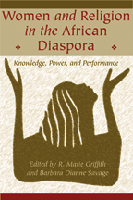
This landmark collection of newly commissioned essays explores how diverse women of African descent have practiced religion as part of the work of their ordinary and sometimes extraordinary lives. By examining women from North America, the Caribbean, Brazil, and Africa, the contributors identify the patterns that emerge as women, religion, and diaspora intersect, mapping fresh approaches to this emergent field of inquiry.
The volume focuses on issues of history, tradition, and the authenticity of African-derived spiritual practices in a variety of contexts, including those where memories of suffering remain fresh and powerful. The contributors discuss matters of power and leadership and of religious expressions outside of institutional settings. The essays study women of Christian denominations, African and Afro-Caribbean traditions, and Islam, addressing their roles as spiritual leaders, artists and musicians, preachers, and participants in bible-study groups.
This volume's transnational mixture, along with its use of creative analytical approaches, challenges existing paradigms and summons new models for studying women, religions, and diasporic shiftings across time and space.
[Return to table of contents]
New Book
Archaeology, Language, and the African Past
By Roger Blench.
AltaMira Press, Hardcover ISBN 0-7591-0465-4, Paperback ISBN 0-7591-0466-2, 336 pp., July 2006.
Description from the Publisher:
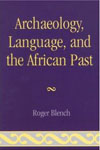
Archaeology, Language, and the African Past is an overview of theories and methods, a fusion of African linguistics and archaeology. Roger Blench provides a comprehensive look at the history of all African language families, incorporating the latest linguistic classifications, current evidence from archaeology, genetic research, and recorded history. This original and definitive volume examines the economic culture of the continent -- from major crops and plant life to animals and livestock -- from a multi-dimensional perspective. It provides students of linguistics, archaeology, and anthropology with a critical discussion on the history of African languages and the cultures they articulate. About the author: Roger Blench is a social anthropologist working in agricultural development and the managing director of Mallam Dendo Ltd., a consultancy company based in Cambridge, UK.
[Return to table of contents]
New Book
Crossing Waters, Crossing Worlds: The African Diaspora in Indian Country
Edited by Tiya Miles and Sharon P. Holland.
Duke University Press, Hardcover ISBN 0-8223-3812-2, Paperback ISBN 0-8223-3865-3, 392 pages, 7 illus, 1 table, August 2006.
Description from the Publisher:
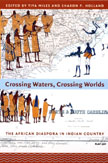
Crossing Waters, Crossing Worlds explores the critically neglected intersection of Native and African American cultures. This interdisciplinary collection combines historical studies of the complex relations between blacks and Indians in Native communities with considerations and examples of various forms of cultural expression that have emerged from their intertwined histories. The contributors include scholars of African American and Native American studies, English, history, anthropology, law, and performance studies, as well as fiction writers, poets, and a visual artist.
Essays range from a close reading of the 1838 memoirs of a black and Native freewoman to an analysis of how Afro-Native intermarriage has impacted the identities and federal government classifications of certain New England Indian tribes. One contributor explores the aftermath of black slavery in the Choctaw and Chickasaw nations, highlighting issues of culture and citizenship. Another scrutinizes the controversy that followed the 1998 selection of a Miss Navajo Nation who had an African American father. A historian examines the status of Afro-Indians in colonial Mexico, and an ethnographer reflects on oral histories gathered from Afro-Choctaws. Crossing Waters, Crossing Worlds includes evocative readings of several of Toni Morrison’s novels, interpretations of plays by African American and First Nations playwrights, an original short story by Roberta J. Hill, and an interview with the Creek poet and musician Joy Harjo. The Native American scholar Robert Warrior develops a theoretical model for comparative work through an analysis of black and Native intellectual production. In his afterword, he reflects on the importance of the critical project advanced by this volume.
Contributors: Jennifer D. Brody, Tamara Buffalo, David A. Y. O. Chang, Robert Keith Collins, Roberta J. Hill, Sharon P. Holland, ku'ualoha ho'omnawanui, Deborah E. Kanter, Virginia Kennedy, Barbara Krauthamer, Tiffany M. McKinney, Melinda Micco, Tiya Miles, Celia E. Naylor, Eugene B. Redmond, Wendy S. Walters, Robert Warrior.
[Return to table of contents]
Society for Historical Archaeology
2007 Conference on Historical and Underwater Archaeology
Old World/New World: Culture in Transformation.
Williamsburg, Virginia, January 10-14, 2007.
 Conference theme: Central to the theme of the 2007 SHA conference in Williamsburg/Jamestown, Virginia, is the historical archaeology of Jamestown in the context of the emerging 16th and 17th century Atlantic World. The program will feature a plenary session focusing on the archaeology of the early decades of European expansion along the Atlantic rim, and what it reveals of the process of cultural change among Europeans, Africans and native peoples. Concurrent sessions are open to presentations on regional or temporal variations on the plenary theme and other individual research projects that incorporate comparative and interdisciplinary research. Innovative use of advanced technology will be a subtheme throughout.
Conference theme: Central to the theme of the 2007 SHA conference in Williamsburg/Jamestown, Virginia, is the historical archaeology of Jamestown in the context of the emerging 16th and 17th century Atlantic World. The program will feature a plenary session focusing on the archaeology of the early decades of European expansion along the Atlantic rim, and what it reveals of the process of cultural change among Europeans, Africans and native peoples. Concurrent sessions are open to presentations on regional or temporal variations on the plenary theme and other individual research projects that incorporate comparative and interdisciplinary research. Innovative use of advanced technology will be a subtheme throughout.
Symposia and a Forum focusing on topics of African diaspora archaeology include:
Symposium: African Autonomy in the Atlantic World. Organizer and Chair: A. Kowal. Participants: M. Young; E. Yates; J. Eberwine; J. McCarthy; A. Kowal; L. Gijanto; M. Wood; D. Sanford. Thursday, Jan. 11, afternoon schedule.
Forum: Research Designs for Atlantic Africa and African Diaspora Archaeologies. Organizer and Moderator: C. Fennell. Participants: W. Battle-Baptiste; K. Deetz; K. Kelly; C. McDavid; P. Mullins; A. Ogundiran; C. Schrire. Friday, Jan. 12, morning schedule.
Symposium: Servitude, Slavery, and the Social Dynamics of the Early Chesapeake: Archaeological Perspectives. Organizer and Chair: F. Neiman. Participants: F. Neiman; J. Galle; L. Nelson, J. Galle and F. Neiman. Friday, Jan. 12, morning schedule.
Symposium: African Diaspora Archaeology in ihe Chesapeake: Current Trends and New Perspectives. Organizer and Chair: D. Brown and T. Harpole. Participants: G. Fesler; D. Brown; T. Harpole; S. Kern; L. Galke; M. Reeves; K. Tinkham; K. Deetz; D. Sayers; E. Jordan. Friday, Jan. 12, afternoon schedule.
Symposium: The African Diaspora in Global Perspective. Organizer and Chair: S. Croucher. Participants: F. Bugarin; K. Kelly; L. Wilson; S. Croucher; A. Laure; J. Delle; T. Tetrault; C. Fennell; H. MacLeod-Leslie; A. Carvalho; D. Hicks; C. McDavid. Saturday, Jan. 13, morning schedule.
Symposium: New Philadelphia: Race and Commerce on the Illinois Frontier. Organizer and Chair: P. Shackel, T. Martin and C. Fennell. Participants: P. Shackel; M. Hargrave and C. Fennell; C. Valvano; E. Helton; T. Martin and C. Martin; C. Christman; C. King; A. Agbe-Davies. Sunday, Jan. 14, morning schedule.
General Session: Expanding the African Diaspora. Organizer and Chair: N. Hamilton. Participants: S. Croucher; N. Norman; D. Miller, N. Norman and J. Monroe; R. Croff; W. Duncan; N. Hamilton, R. Sanford, R. Talbot-Ross and M. Rowe; H. MacLeod-Leslie/ D. Palmer; C. Duke and R. Goodwin. Sunday, Jan. 14, morning schedule.
Abstracts:
Jan. 11, 2007, Symposium entitled African Autonomy in the Atlantic World: Whether enslaved or not, people of African descent faced difficulties in attaining autonomy in historic times, which continues in the present. External pressures impinged on many African descendants who managed through cultural developments and continuities to maintain their cultural identities. Several were not independent, although their communities thrived in the face of slavery, persecution, and prejudice. These Africans wielded their power through their kinship practices, ideology, culinary traditions, burial practices, and landscape and settlement patterns. Archaeology and Anthropology in conjunction with other disciplines enlighten modern researchers on the experience of African descendants throughout the Atlantic world, and the levels of autonomy they were and are capable of achieving despite the pressures they faced.
Jan. 12, 2007, Symposium entitled African Diaspora Archaeology in the Chesapeake: Current Trends and New Perspectives: African Diaspora archaeology in the Chesapeake region has evolved over the past 35 years from a peripheral element of historical archaeology to one of the central components of our field. The recent development of new research tools that let archaeologists compare materials between sites (such as the Digital Archaeological Archive of Comparative Slavery) also allow closer scrutiny within sites. The compilation of African Diaspora data across the Chesapeake has brought greater meaning and analytical possibilities to single site assemblages that reflect differences over time and varying uses within changing plantation and agricultural systems. In this session we have brought together a group of archaeologists actively excavating African Diaspora sites in the Chesapeake. Some of this work has been hidden in the gray literature, some of the more well-known sites are due for a thorough reanalysis, and some of the sites are fresh out of the ground.
Jan. 12, 2007, Forum entitled Research Designs for Atlantic Africa and African Diaspora Archaeologies: This forum will focus on theoretical constructs and interpretative frameworks employed in African diaspora archaeology projects and comparative studies in the historical archaeology of sites in Africa. Subjects for discussion include questions such as the following: What theories of agency and process have proven most useful in interpreting archaeological data from such sites? How are researchers connecting theoretical issues to the material culture they are interpreting? Which interpretative frameworks have proven successful in public archaeology and cultural heritage projects? In formulating interpretations of available data, how are researchers dealing with evidentiary gaps created by the past impacts of colonialism and slavery? To what degree have approaches based on processualism, practice theory, feminist theory, critical theory, neo-Marxist theories, theories of ethnicity and racialization, or critical race theory resulted in persuasive accounts of past dynamics? Have particular concepts, such as creolization, resistance, double-consciousness, ethnogenesis, globalization, or world systems, proven useful?
Jan. 13, 2007, Symposium entitled The African Diaspora in Global Perspective: The African Diaspora is vast, and its archaeological study includes investigations from widely-dispersed geographical locations, from Africa itself to the many regions of the world which became home to diasporic African populations. Within this scope, the experiences of those involved in, and affected by, the diasporic process varied widely. This session brings papers together that reflect the global reach of this topic of enquiry, including those from East and West Africa, Canada and Latin America. This range allows for reflection upon two main themes. Firstly, the question of what unites these diverse studies? Which points provide useful comparisons between disparate areas? Secondly, the question of what makes each study unique within its local context, highlighting the variety in this field. These topics will be actively explored throughout the session, which takes a truly global approach to an expanding field.
Jan. 14, 2007, Syposium entitled New Philadelphia: Race and Commerce on the Illinois Frontier: Founded by a freed African American, New Philadelphia existed on the Illinois Frontier as a small farming center between the Illinois and Mississippi Rivers. Extensive research about Free Frank McWorter and his family has been gathered and published by historians. The recent archaeology program provides different insights into the development and eventual demise of the community. Archaeology, oral histories, and the examination of tax records and census data provide a picture of a dynamic community that succumbed to shifting markets, and the rerouting of roads and railroad lines. By 1930 the town disappeared from the prairie landscape.
[Return to table of contents]
Call for Papers
Association for the Study
of the Worldwide African Diaspora.
Fourth Conference, Barbados, October 9-12, 2007.
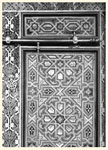
You are invited to participate in the fourth conference of the Association for the Study of the Worldwide African Diaspora (ASWAD), to be held October 9-12, 2007, in Barbados. The University of the West Indies, Cave Hill is hosting the conference as its Signature Program for the year, with co-sponsorship from New York University.
In commemoration of the Bicentennial of the British and American Abolition of the Transatlantic Slave Trade, the theme of the conference is Interrogations of Freedom: Memories, Meanings, Migrations.
The conference will be research driven, featuring panels organized in ways which effectively stimulate discourse across geographic, disciplinary, cultural, and theoretical boundaries. All geographic areas will be represented, including Africa, the Middle East, Europe and Asia. Paper and panel proposals that incorporate gender and women as categories of analysis are encouraged.
Proposals: Please send a two-page abstract (for either a single presentation or a panel) and a one-page cv (or one-page multiple cv's) by March 1, 2007. They can be sent prior to submitting the registration fee, and are to be sent electronically via email attachment to: Barbados07@nyu.edu. Other queries (but not abstracts; please send all abstracts to barbados07@nyu.edu) can be addressed to: Michael Gomez, Dept. of History, New York University, 53 Washington Sq South, NY, NY 10012-1098; Ofc: 212-998-8624; Fax: 212-995-4017; michael.gomez@nyu.edu.
We intend to post papers on our website, and some may be selected for publication. If you do not wish your paper to appear in either format, please clearly indicate such. Completed materials should be submitted in publishable form prior to October 9, 2007.
[Return to table of contents]
Call for Papers
Journal of Pan African Studies.
Special Issue on Black Spirituality.
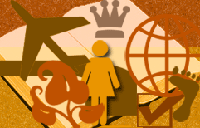
'BioDun J. Ogundayo of the University of Pittsburgh is guest editing a special issue of the Journal of Pan African Studies. This edition offers scholars, theorists, researchers, and practitioners opportunities to reassess, contest, and/or elaborate notions/theories of Black Spirituality.
This issue is particularly relevant today because religious fundamentalism (and spirituality) has become key in the raging battles of ideologies and identities around the world.
This is not an exhaustive list. Topics/themes/rubrics to be addressed will include, but are not limited to:
-- The role of the Black American Church in the Information Age (mega-churches; civil rights, American politics)
-- The role(s) of African Initiated Churches (AICs) in modern African politics
-- African immigrants and spiritual expression (USA, Canada, Europe, etc.)
-- Black/African Secret Societies
-- Black/African Ways of Knowing
-- Islam, African-Americans, and Africans
-- Blacks/Africans and Eastern Religions and Spirituality
-- The Spirituality of Black/African women: Africa and the Diasporas
-- Black/African Spirituality and methods/modes of conflict resolution
-- Black Sexuality and Religion in Modern Society
-- The Black/African Family as a Spiritual Unit: Lessons for the world
-- Art, Language, Voice, and Literature: Expressions of the Black
-- Spiritual experience (this section could include artwork, poetry, short essays/testimonial? . . .)
-- Time, History in Black/African Spirituality.
General Information: The Journal of Pan African Studies seeks articles or creative work that: present original research methods/theory, add to a body of research, announce research findings, guide future research, explore theories, distribute new knowledge, present new ideas, invite discussion, introduce research reviews, and new Pan African Studies centered terminology. Hence submitted articles should have an introduction, literature review (annotated bibliographies accepted), methodology, results, discussion, conclusions, and steps for further research that can intellectually engage researchers, scholars, students and professionals. The journal is published four times a year (March, June, September, December), and abstracted and indexed in the International Index to Black Periodicals.
Requirements: All manuscripts must be original (hence, not under consideration at any other journal) and submitted in MS word format via ogundayo@pitt.edu. The entire work should not exceed twenty double-spaced pages with a concise title, abstract, and scholarly citation (MLA style); articles in languages other than English will be considered, however they must also be presented in English, and all submissions must list the author's current affiliation and contact points (e-mail address, etc.).
Please address manuscripts to: 'BioDun J. Ogundayo, Ph.D., University of Pittsburgh, 300 Campus Drive, Bradford, PA 16701; ogundayo@pitt.edu.
Deadline: All manuscripts must be received by Summer 2007.
[Return to table of contents]
Call for Papers
Africa and the Transatlantic Slave Trade:
Revisiting the Olaudah Equiano Legacy.
An International Interdisciplinary Conference.
Imo State University, Owerri, Nigeria, July 26-27, 2007.
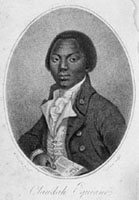
Olaudah Equiano's autobiography, The Interesting Narrative of the Life of Olaudah Equiano, or Gustavus Vassa, the African, published in 1789, is one of the few texts written in English by a person of African descent during the eighteenth century. Until recently, its impact as an account of a journey up from slavery written by one who had personally experienced the middle passage and subsequent enslavement has been monumental. Recent interest in Equiano has been motivated by contemporary developments, such as the work of Vincent Carretta, a professor of English at the University of Maryland at College Park and author of, Equiano, the African: Biography of a Self-Made Man, which has raised questions of "where Equiano was actually born and claimed that he "may have invented rather than reclaimed an African identity." The controversy generated by the discovery of Olaudah Equian's baptismal records has led some to question the authenticity of his place of birth and indeed other slave narratives, especially those which purport to document the middle passage experiences of African slaves aboard slave ships enroute to the New World, call for a critical re-assessment of the existing scholarship.
In this context the aim of the conference is to evaluate potentials and deficits in the scholarship. The conference will also be a platform for an exchange of ideas and an opportunity for researchers and students to present on-going research on Equaino and work within a variety of fields and disciplines. We invite a wide range of scholars working out of different contexts, disciplines, and interests to either reinterpret/revisit any of the major debates in these fields, or ask new questions that seem important. All researchers on Equaino as well as academics who have recently entered the field are encouraged to contribute.
Proposals are invited covering a range of topics as they relate to Equiano's legacy including, but not limited to:
-- Race, Roots, and Identity
-- Migration, Immigration, Exile
-- Sovereignty, Freedom, Justice
-- History, Culture, and Ethnicity
-- Knowledge production
-- Abolition of slavery.
Proposals with a short abstract should be submitted by 30 April 2007 online at http://www.africaresource.com/conferences/index.php?cf=9. Project Committee: Prof. Catherine Acholonu, The Catherine Acholonu Research Center for African Cultural Sciences, UNCCD Forum of Arts and Culture, PMB 5197, Abuja, Nigeria; tel. 234-80-57751297. Prof. Dorothy Ukaegbu, Department of Anthropology, Community College of Southern Nevada, USA; dorothy_ukaegbu@ccsn.edu. Dr. Chris Osuafor, Department of English and Literary Studies, Imo State University, Owerri, Nigeria; tel. 234-80-33331628; krisafor@yahoo.com. Prof. Chima J. Korieh, Professor of African History, Department of History, Rowan University, Glassboro, NJ 08028, USA; Korieh@rowan.edu. Prof. Felix Madubuike, Department of History, Imo State University, Owerri, Nigeria.
[Return to table of contents]
Call for Papers
Caribbean Studies Association
32nd Annual Conference.
Salvador da Bahia, Brazil, May 28 to June 1, 2007.
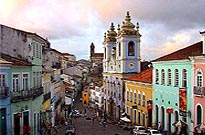
Conference theme: "Alternative Interpretations of the Circum-Caribbean: Interrogating Connections across History, Society, Culture, and Performance."
Our aim is to advance the dialogue among and between scholars and practitioners in efforts to chart a course for the practical engagement of academic researchers with the problems facing the Caribbean region. By hosting the conference in Brazil, we seek to challenge the popular understandings of the Caribbean by emphasizing the cultural, historical, and social spaces rather than the national and territorial in its conceptualization.
We seek scholarly papers from individuals spanning the broadest disciplinary and methodological range whose work focuses upon the Caribbean and its Diaspora. In this we include and encourage:
-- Papers from the Circum Caribbean region incorporating Central America, Colombia, Venezuela, Mexico, and North-East Brazil;
-- Contributions from professionals, those engaged in the formulation and implementation of public policy, and public and private sector administrators;
-- Papers that interrogate the theme of connections across the Circum-Caribbean;
-- Papers that strive to enhance and preserve the rich cultures of the region;
-- Presentations from artists in film, music and theatre.
While we consider individual papers, we strongly encourage submissions of entire panel proposals with themes intended to provoke stimulating discussion and debate. We also encourage and welcome graduate student papers and panels.
Please submit an "Individual Abstract Form" if you are submitting an individual paper or the "Panel Abstract Form" for panels. The appropriate form as well as a brief CV for each presenter must be submitted by email no later than December 22nd, 2006 to Caribbean_2007@yahoo.com. As you will note, individual abstracts should not exceed 200 words. Panel abstracts should not exceed 100 words for the general panel description and 100 words for each presenter. Panel chairs will be responsible for communicating with their panel members. All paper presentations will be allocated an absolute maximum of 15 minutes. For more information, please visit our website at: http://www.caribbean-studies.org
[Return to table of contents]
Call for Papers
Carolina Low Country and Atlantic World
Commemorating the Abolition of the Atlantic Slave Trade.
Charleston, South Carolina, March 26-29, 2008.
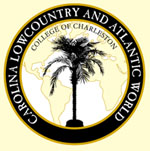
To mark the Bicentennial of the abolition of the Atlantic Slave trade in the United States and the British Empire, the Program in the Carolina Lowcountry and Atlantic World (CLAW) at the College of Charleston will hold a conference from March 26-29, 2008, focusing on the trade, and its effects on the Lowcountry and the American South as a whole. Topics to be covered include: African culture in the Lowcountry; Lowcountry Caribbean trade connections; impact on the southern economy; the growth of the internal slave trade; Charleston as a slave trading center; influence on pro- and anti-slavery ideology; the growth of "scientific" racism; attempts to reopen the trade; and the illegal importation of slaves.
As one of the key nodes for the importation of slaves into continental North America, Charleston is a prime location for a conference such as this. It was a major entrepot for African and Caribbean slaves and, as Walter Johnson has highlighted in Slave by Slave, also a major transit point for slaves being transferred from the upper South to the deep South. In addition, Charleston politicians such as Robert Barnwell Rhett were major supporters of attempts to reopen the trade. This conference will be the academic culmination of a city-wide series of events marking the bicentenary and beginning to address Charleston's role in the international slave trade (and its legacy) more directly and thoroughly than ever before. It is therefore in line with a number of local initiatives that will address the "acknowledgment gap" between white and black contributions to local culture and history -- most prominent among these efforts are the federally supported Gullah-Geechee and the city's commitment to its proposed International African American Museum. Because of the density of slave trade-related sites people attending the conference will have an unparalleled opportunity to tour historically pertinent sites, including local archives as well as buildings, plantations, and the like.
Abstracts of between 250 and 400 words, accompanied by a 2-page c.v., should be sent to conference convener Simon Lewis at lewiss@cofc.edu
before Friday, July 20th, 2007. Notification of acceptance will be sent out by the end of August, and completed papers will then need to be submitted electronically before January 21st, 2008, so that all accepted papers can be posted in full on a password-protected website prior to the conference. At the conference itself, presenters will have ten minutes each to extrapolate from their written papers and engage in seminar-style discussions with their colleagues. In our previous conferences on such topics as the Haitian Revolution, Manumission in the Atlantic World, and Lowcountry and Caribbean foodways, we have found this process to be highly productive and intellectually invigorating because of the ample time available for discussion and the opportunities junior scholars have to interact with the major players in their field.
Among the scholars who have already committed to the conference as speakers, panel chairs, commentators, or presenters are: Paul Lovejoy, Joseph Inikori, Kenneth Morgan, Jerome Handler, James Walvin, David Eltis, and Vincent Carretta. For further information on the Carolina Lowcountry and Atlantic World program, please visit our website at www.cofc.edu/atlanticworld or call Simon Lewis at 843-953-1920.
[Return to table of contents]
Editor's Note on Book Reviews
I often publish selected book reviews in this Newsletter from H-Net, the Humanities and Social Sciences Online service, which makes such reviews available for reproduction for educational purposes. Other reviews are available on the H-Net Reviews web site.
John McCarthy is now working to coordinate book reviews to be written for this Newsletter, and he has received review copies of a number of books from presses that he can supply to individuals who agree to write a review of such recent publications. If you, or someone you know, would be interested in book review assignments for the African Diaspora Archaeology Newsletter, please drop John a note, at strongjohn10856@gmail.com. A reviewer receives a free copy of the book. -- Chris Fennell.
[Return to table of contents]
Book Review
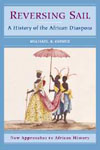
H-NET BOOK REVIEW
Published by H-Atlantic, http://www.h-net.org/~atlantic/ (November 2006).
Michael A. Gomez. Reversing Sail: A History of the African Diaspora. New Approaches to African History Series. Cambridge: Cambridge University Press, 2005. xii + 236 pp., Figures, maps, index. $19.95 (paper), ISBN 0-521-00135-8.
Reviewed for H-Atlantic by Ty M. Reese, Department of History, University of North Dakota.
Race, Agency, and the African Diaspora
For many, the African Diaspora remains synonymous with the infamous transatlantic slave trade. In Reversing Sail, however, Michael Gomez shows that the integration of Africa and Africans into Europe and the Americas resulted in more than the exploitation of African slaves. In his new work, written as an undergraduate textbook, Gomez explores the duration, complexity, and agency of the African Diaspora in a way that lays the foundation for interesting in-class discussions of the issues raised.
Gomez examines the history of the African Diaspora by dividing his work into two sections. Part 1, consisting of three chapters, explores the "Old World Dimensions" while part two, consisting of five chapters, examines "New World Realities". The work begins by exploring the place of Africans in the early Mediterranean world and Gomez uses this framework to stress two important issues. First, he emphasizes that both Africa (and Africans) possessed a history before Europeans arrived on its shores in the fifteenth century and, consequently, that the transatlantic slave trade that caused the Diaspora "was but an aberration" (p. 7). Gomez then addresses biblical Africa(ns) in chapter 2 to explain the place of Africans in scripture, interpreting figures such as the Queen of Sheba while also setting up the role of Christianity in the African Diaspora. In chapter 3 Gomez considers the other monotheism that influenced Africa and, like Christianity, played a role in the enslavement and movement of Africans: Islam. The overarching point that Gomez makes in these early chapters is that Africans were not passive peoples without a history, but rather played a dynamic role within each of the contexts he examines.
From Africa, Gomez moves, in chapter 4, to the western Atlantic basin and the realities of the Europeans' New World. As Europe expanded into the Atlantic, the focus of West Africa shifted from the north, and the trans-Saharan trades, to new coastal Atlantic trades, which, in turn, laid the foundations for the transatlantic slave trade. Here Gomez argues that several factors -- religious competition and conflict, the development of transoceanic trade, the movement of sugar production westward across the Atlantic, and New World conquest/settlement -- caused Africans to become the "principle source of servile labor, laying the foundations of the modern world" (p. 59). In the remainder of this chapter, Gomez creates a general history of the transatlantic slave trade that has a short section on the various coastal regions followed by a longer section on the Middle Passage. Changing scene but not focus, chapter 5 explores what happened to the Africans after they arrived, as slaves, in the Americas. Dominant themes within this chapter involve the regional variations of slavery coupled with the rise of race -- a construct with important repercussions for the African Diaspora.
After recounting Africans' experiences of enslavement, Gomez guides the reader through the development of the abolitionist movement, with the ingenious agency of slaves in challenging the peculiar institution providing an apt counterpoint in chapter 6. As in the previous chapters, Gomez relies upon the existing historiography to create a general but insightful history of the struggle for freedom. Themes include the multiple meanings of freedom, the role of the family and religion in slave resistance, the return to Africa movement, and how, with emancipation, ex-slaves received little as many continued to live within a system of servile dependency. Chapter 7 builds upon the theme of freedom by exploring how, in post-emancipation societies, the peoples of the African Diaspora attempted to reconnect to Africa in an attempt to better define themselves. This reconnection, often centered on the Caribbean, involved migration, labor organization, religious development, and the growth of specific political, ideological, and intellectual traditions. The section on religion, in which Gomez looks at the Africanization of Christianity, the continuity of African traditions in the Americas, and the creation of new religions such as the Rastafarian movement, is especially interesting. The book ends with an examination of the achievements of the Diaspora community from the
1940s until 1970.
While a short work, Gomez provides the reader with not only an introduction to the many issues of the African Diaspora, but also with insight into the people who participated in, and are still affected by, the Diaspora. While at times the work appears broad, through his selective sections within each chapter Gomez still manages to elaborate upon some of the debates surrounding the Diaspora. Although an obvious strength, these disquisitions are at the same time one of the work's problem areas in that Gomez raises numerous questions that he never fully answers. While this approach serves the purpose of the "New Approaches to African History Series" of which Reversing Sail is a part, too often it also lends the work an unfinished quality. A typical example of this tendency involves how Gomez treats the issue of culpability for the transatlantic slave trade. Work on West Africa during the transatlantic slave trade has shown that the coastal African middlemen and states involved in the slave trade dictated the nature of the trade and that European slavers needed to react to these coastal demands. From this develops an obvious question: who is to blame? Yet this is such a complex question, with such a multiplicity of answers, that students will need more than just a very general introduction to the issue to formulate their own answers. A second issue concerns Gomez's specific choices in terms of content. It would be easy to argue for or against what Gomez decided to include in his work, including the length and detail of various sections. Yet here, in my view, we must deal with the work that Gomez created and it is obvious that all of his inclusions were well thought out and clearly contribute to the larger goals of his work. In sum, while the above observations should be kept in mind by those teaching this text, the work's utility as an undergraduate text is unquestionable.
One of the text's greatest strengths is that it shows that the people affected by the African Diaspora were not passive participants. Rather they actively responded to their changing situation and worked hard to protect themselves, their families, and their friends in the new circumstances in which they found themselves. This becomes even more evident as Gomez explores the development of race within the second section of the work and how race redefined the place of Africans within the developing Atlantic world. As an undergraduate text, the work serves an important role in that it provides a general history while raising questions that a class could explore and debate. For those familiar with the history and historiography of the African Diaspora the text adds little, but that is not its purpose.
Copyright (c) 2006 by H-Net, all rights reserved. H-Net permits the redistribution and reprinting of this work for nonprofit, educational purposes.
[Return to table of contents]
Book Review
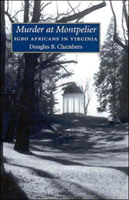
H-NET BOOK REVIEW
Published by H-Atlantic, http://www.h-net.org/~atlantic/ (October 2006).
Douglas B. Chambers. Murder at Montpelier: Igbo Africans in Virginia. Jackson: University Press of Mississippi, 2005. x + 325 pp., Illustrations, maps notes, bibliography, index. $45.00 (cloth), ISBN 1-57806-706-5.
Reviewed for H-Atlantic by Gloria Chuku, Department of History, Millersville University of Pennsylvania.
Enslaved Igbo and the Foundation of Afro-Virginia Slave Culture and Society
Based largely on court and county documents as well as the recently published transatlantic slave database, Douglas Chambers uses the circumstances surrounding the 1732 death of Ambrose Madison, the paternal grandfather of President James Madison, to reconstruct the history of the Igbo slaves in Virginia. Thus, the book is primarily about the dominant role of enslaved Igbo in the formation of early Afro-Virginia slave culture and society. In the words of the author, it discusses "the process of historical creolization in eighteenth-century Virginia . . . [which] effectively mean[s] the Igboization of slave community and culture" in the region (p. 18). The book breaks into two parts: part 1 consists of chapters 1-4, and part 2 consists of chapters 5-10.
Three slaves, two men and a woman, were accused of causing Madison's death by poisoning. They were tried and found guilty. While one of the accused, a male slave owned by a neighboring planter, was executed for his alleged lead role, the other two, owned by Madison, were punished by whipping and returned to his estate.
As a foundation for his thesis, Chambers attempts to trace the history of the enslaved Africans from their points of embarkation in the Bight of Biafra and, more specifically, Calabar to their disembarkation in Virginia. Thus, while part 1 of the study focuses on the Igbo and their culture and society during the era of the transatlantic slave trade, part 2 centers on the experiences of the enslaved in Virginia. The author argues that the emergence and expansion of Aro influence in Igbo region, as the foremost slave merchants, and the demise of Nri hegemony in the north-central Igbo region in the mid-eighteenth century resulted in increased exportation of Igbo people out of the Calabar and the Niger Delta ports. According to the author's calculations, the Igbo accounted for about 1.3 million of the 1.7 million people exported from the Bight of Biafra during the era of the Atlantic slave trade. Out of a total of 37,000 Africans that arrived in Virginia from Calabar in the 1700s, 30,000 were Igbo (p. 23). The significance of this pattern of slave trade between Calabar and Virginia, Chamber argues, is that the increased exportation of enslaved Igbo from their homeland to the Chesapeake region coincided with the expansion of colonial settlement from the Upper Tidewater to the fertile Central Piedmont, an era when the transatlantic trade transformed the region into a slave society that was dominated by the Igbo and their culture.
In 1721, Ambrose Madison inherited an estate at Mt. Pleasant from his father-in-law. To secure title to this estate, he purchased newly imported African slaves and sent them there to clear and cultivate crops. In early 1732, he moved to the new estate with his family. Six months later, while still in his mid-thirties, he died, allegedly as a result of poison. As the author states, while Madison's biographers and hagiographers helped to create a general impression that he died a strange death at a very young age, his family members attributed his death to a poisoning conspiracy involving two of his slaves and an outside male slave. To buttress his claim that Igbo slaves were responsible for their master's death, Chambers, in a chapter of only five pages, attempts to link the use of poison as a weapon of slave resistance to the enslaved Igbo in Virginia and the Caribbean colonies. This is very subjective, since the knowledge and use of plant medicines to heal the sick, placate the spirits and punish enemies and deviants was not the exclusive prerogative of the enslaved Igbo.
In part two of the book, which focuses on Virginia, the author delineates five phases of the creolization of Mt. Pleasant (later Montpelier), namely, the Charter generation (1720s-1730s), the Creolizing generation (1740s-1760s), the Creolized generation (1770s-1790s), the "Worriment" generation (1800s-1820s), and the Ruination generation (1830s-1850s). The charter generation of Atlantic Africans marked the development of Mt. Pleasant as a regional slave community of the Madison family with twenty-nine slaves. It was an era when enslaved Africans employed their cultural heritage to adapt to their new environment. They not only employed their expertise in tropical agriculture to cultivate tobacco and corn, but also put into use their knowledge of herbs and plants to make preventive, curative, and poisonous medicines. Upon Madison's death, his family shared his slaves between his two quarters: the Home House and Black Level, an action which signifies a new settlement pattern.
The Creolizing generation of the Montpelier slave community saw a steady growth in the slave population, resulting largely from inheritance and births. Under the leadership of James Madison Sr., the family embarked on major construction projects that made each of their quarters resemble a small village. They also established large tobacco barns, corncrib, and a mill. Wealth generated through slave labor enabled Madison to enhance his economic and political status. For closer supervision and increased productivity, he broke his slaves into small workforces and deployed them annually to live in different quarters in a rotating order. However, following the building of the Home House and the slave quarter, the Walnut Grove, Madison brought many of his slaves to stay at the core Montpelier community in the late 1760s.
The Creolized generation (1770s-1790s) marked the high point of Montpelier as a slave community that was centered on the Walnut Grove, with over hundred slaves in the mid-1770s (p. 129). While tobacco remained the main export crop, Madison was able to diversify his business operations to include blacksmithing, carpentry, and brandy distilling. He also added wheat and hay to his list of crops. Before he died in 1801, Madison also invested in plows, scythes, and other grain-cultivating tools which facilitated increased production and specialization by the slaves.
The "Worriment" (1800s-1820s) and "Ruination" (1830s-1850s) generations marked the death of James Madison Sr., the disputes over the division of his estates, the first substantial separations of slaves from the home community, the death of President Madison, and the final divestment of what was left of the Montpelier community. By 1860, under a new owner, the Montpelier slave population had been so drastically reduced, either through intra- and inter-state slave trade or the manumission process, that only twenty slaves were left on the estate.
As the author aptly observes, in spite of the predominant role of enslaved Africans in the development of Mt. Pleasant and their contribution to the rise of the Madison family to regional prominence, historians have tended to overlook them, focusing on Montpelier only as the family home of President Madison. A few of the blacks mentioned in the historiography of the Madisons were Sawney, Billy Gardner, Granny Milly, Paul Jennings, and Surkey. Paul Jennings, who published a small pamphlet in 1865, was a sixteen-year-old house slave at the White House in 1814, attending to the president until his death, and Sawney accompanied the young James to his college in New Jersey and served as his manservant. He also served as an overseer, cultivated yams and cabbages, and raised chickens before his death in the 1830s.
In the last chapter, the author tries to reinforce his claims that Igbo slaves killed Ambrose Madison and that their predominance in Virginia gave them the opportunity to lay the foundation of the Afro-Virginian culture and community. For this purpose, he uses the personal names of the enslaved to mark their individuality and to connect them to the Montpelier slave community and the broader history of the region. The author mentions names such as Calabar (male), Eboe Sarah (female), Juba (male,) and Breechy (male). He also uses yams (a staple food) and okra (a vegetable) as evidence of the foodways of Igbo origins, as well as mojo for charms, and the slave Jonkonnu (a Christmastime slave masquerade), all in the attempt to make a case for what he calls "creolized Igboism" in Virginia.
Chambers also associates the eighteenth-century low-fired ceramic cooking pots and eating bowls (generally called colonoware) with the enslaved Igbo. According to the author, the "description of precolonial Igbo potting technology fits quite well with what is known of eighteenth-century Virginia colonoware . . . [and] gourds (calabashes) were another important Igbo material cultural item that continued in Virginia" (pp.172-173). Other material culture the author lists in the book, as signifying Igbo connection, are dugout canoes, styles of fences, blue glass beads, and an iron sculpture which he claims evokes the kinds of figures made from wood or clay that littered southern Igbo mbari art or even ikenga (p. 174). The author identifies musical instruments such as box drums and the banjo stringed instrument as uniquely Igbo. He also points to slave patterns of settlement, Igbo belief in reincarnation, the practice of not celebrating birthdays, and the nudity of enslaved children and youths as practices which resonated in Afro-Virginian culture and suggest the dominance of Igbo influence. The author draws on the extreme lactose intolerance among Virginia's black adults of the nineteenth century and the related notion that the Igbo and Yoruba were the only major African ethnic groups with a known lactose intolerance (p.186). In addition, he says that the high proportion of Igbo women in the colony might have given them disproportionate influence in the socialization of Creole children.
As a counter-thesis to that of the author, it should be noted that yam-growing was and is not peculiar to the Igbo; more importantly, North American yams are actually sweet potatoes, not the genus Dioscorea associated with West Africa. Similarly, the paraphernalia associated with the Christmastime slave masquerades that the author links with the Igbo were actually more related to mid-twentieth-century century Kalabari masks. As for calabashes, as the author notes, these were used as gourds in Virginia; by contrast, calabashes were used as cups, bowls, and drinking ladles in Igbo society. Regarding musical instruments, while many central African peoples called their version of stringed gourd mbanza, there is no Igbo name for the musical instrument the author identifies as banjo. The author believes that most of the enslaved Igbo who came from Calabar were from the north-central Igbo region, the home to the famous Umudioka woodcarvers. I would argue that the absence of carved doors and panels in Virginia undermines the idea of a north-central Igbo provenance of Calabar slaves and a pervasive Igbo presence and culture there.
While there may be some credibility in the above claims, it is apparent that some of the cultural practices attributed to the Igbo in this study were neither unique nor exclusive to them. To start with, the Igbo were not the only enslaved Africans who originated from the Niger Delta and Calabar ports, and ended up in Virginia. There were also the Ibibio, the Efik, the Andoni, the Ubani, the Okrika, the Kalabari, and, later, the Ejagham, the Ekoi, the Idoma, the Igala, and even the Hausa and Nupe -- captives from the nineteenth-century Muslim-engineered wars. Besides, Virginia had slaves from the Yoruba, the Akan area, Mande, Fulani, Angola, the Congo basin, and Madagascar. The period covered by the book also coincided with the Islamic militancy of the eighteenth and nineteenth centuries in the Senegambia, an upheaval that resulted in the enslavement of the natives. Virginia was, in other words, a very multi-ethnic slave society. The lack of attention to other Africans in Virginia and the related neglect of their obvious contributions to the development of the region is a major weakness of this study.
It is clear that the author's interpretation and analysis was handicapped by his limited knowledge of Igbo history, culture,e and language. For instance, he erroneously regards the Nri as the "first Igbo" (pp. 36-38) and treats them as founders and leaders of the entire Igbo nation. This explains why he spends considerable time in discussing the Nri kinglist and genealogical history, which is less important for purposes of his study; the book would have benefited more if he had instead focused on the Aro, Nike, Abam, Aboh, Ngwa, Ndoki, Nkwerre, and others who participated in the transatlantic slave trade. It is also erroneous to claim that the Nri were the only people in Igbo society with the power to cleanse abominations. The author asserts that the "expansion of Aro merchant warlord settlements" (p. 35) in the mid-eighteenth century led to the growing power of client village groups within Nri area. However, no examples of such Aro-client villages in north-central Igbo region are provided.
It is misleading to suggest that there was no cassava in the region until the twentieth century and that "fufu in Igboland was invariably made of yams, not cassava" (p. 40). Cassava was introduced in different parts of Igbo region at different points in time. While some areas started cultivating and processing the crop in the third quarter of the nineteenth century, others adopted it in the twentieth century. Moreover, fufu was also made from cocoyam, unripe plantain, and banana and, later, cassava. The incident attributed to the "Nkwerre," who supposedly plundered Onitsha women traders when they brought European goods to the Nkwerre markets, and the author's interpretation and suggestion that the women were molested for usurping males' trading prerogative that violated Nkwerre taboo, are examples of his limited knowledge of Igbo society and history. The town in question was Nkwelle, which is twenty miles from Onitsha, not Nkwerre, which is much farther away. Moreover, Onitsha women were famed traders who not only bought and sold local and European goods, but also had direct commercial relations with European merchants from the moment the latter arrived in Onitsha. As studies on the development of trade and commerce in the Onitsha region show, it was not until the twentieth century that Onitsha men, who regarded trade as women's work, began to take part in trade with the European firms.
The author's claim that "Igbo people brought the term ['buckra'] into English" (p. 110), as in "buckra ," a term used by slaves to refer to their white masters, is doubtful. While "buckra" might be a corruption of Ibibio mbakara (mb equals plural; kara equals to encircle, rule, or abuse), one cannot see the connection of this word with the Igbo. Similarly, he suggests that the slave name "Juba" was Igbo (meaning: ji for yam and uba for canoe, literally translated to mean "yam barn"), "and that Juba" could actually be translated into Igbo words for "ask /enquire," or "refuse," or "possession of wealth" (ji-uba), or "plentiful yam." It is more likely that "Juba" was an Akan name (as in the case of Akan female name in South Carolina and Jamaica) than Igbo name.
In spite of the drawbacks I have pointed out, and occasional typographical errors, the author has assiduously provided an African-centered perspective that helps in our understanding of the circumstances surrounding the death of Ambrose Madison in 1732 and the development of his family into a prominent regional, and indeed, national economic and political power, as well as the contributions of his slaves in achieving these feats and to the foundation and growth of slave culture and society in Virginia. The book represents a limited but significant contribution to the history and historiography of slavery and, therefore, a valuable resource to students and scholars in the study of Africa and the diaspora.
Copyright (c) 2006 by H-Net, all rights reserved. H-Net permits the redistribution and reprinting of this work for nonprofit, educational purposes.
[Return to table of contents]
Book Review
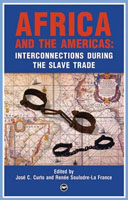
H-NET BOOK REVIEW
Published by H-Luso-Africa, http://www.h-net.org/~lusoafri/ (November 2006).
José C. Curto and Renée Soulodre-La France, eds. Africa and the Americas: Interconnections during the Slave Trade. Trenton and Asmara: Africa World Press, 2005. vii + 338 pp., Illustrations, notes, glossary, bibliography,
index. $99.95 (cloth), ISBN 1-59221-271-9; $29.95 (paper), ISBN 1-59221-272-7.
Reviewed for H-Luso-Africa by Jelmer Vos, National Institute for the Study of Dutch Slavery and its Legacy (NiNsee), Amsterdam.
Circuitous Connections Cut Short
This book, a collection of essays from a conference held at York University in October 2000, sets out to shed new light on the interconnections between Africa and the Americas that grew out of the transatlantic slave trade and were fundamental to the shaping of the Atlantic world. As the editors, José Curto and Renée Soulodre-La France, point out in the introduction, the relationship between Africa and the Americas in the three centuries before 1850 was not constituted solely by a unidirectional traffic of black slaves from the Old to the New World. Another key element in the formation of the Atlantic world was a continuous back-and-forth contact between the economies and cultures of the regions connected through the slave trade.
Highlighting the "interactive linkages" (p. 3) -- alternatively called "circuitous exchanges" (p. 5) or "circuitous linkages" (p. 7) -- between Africa and the Americas during the Atlantic slave trade, the editors claim this collection to be the latest contribution to a "new paradigm" (p. 3) in the study of the African Diaspora. But regardless of the quality of the individual contributions, I fear that the editors have overrated their assemblage. First, the volume lacks the clear geographical focus that has, at least to a large extent, accounted for the strength of similar collections.[1] On the American side the emphasis is on Brazil, which is justified by the fact that in the history of the slave trade Brazil received by far the largest number of African slaves of all American regions (about 45 percent of the 10.7 million slaves disembarked in the Americas). But Spanish America and the Caribbean are also included, while on the African side the regions range all the way from West to East Africa. Furthermore, only two of the twelve chapters assembled here (those by Soumonni and Capela) deal with influences from the Americas on Africa. Two other contributions (Dale Graden's chapter on the collective action of slaves in the port of Bahia in the mid-nineteenth century and João Reis's detailed analysis of the late nineteenth-century organization of Bahian street laborers in work groups called "cantos") do not really tackle the connection theme at all. The editors claim that all chapters together make "a well-balanced volume on the circuitous linkages between Africa and the Americas" (p. 7) and that with this collection the "new paradigm" in African Diaspora studies "begins to reach its logical conclusion" (p. 3). This reader was rather struck by its lack of unity and purpose.
David Eltis, Stephen Behrendt and David Richardson open the volume with a comparison of the transatlantic slave trade along national lines, building on data provided by the Trans-Atlantic Slave Trade Database published in 1999.[2] Their quantitative analysis is meant to serve as a background for the chapters that follow, although almost none of the latter actually refer to it. In the five years after this paper was presented at York University extensive new research has been carried out to expand the 1999 database. This has resulted in the addition of approximately 7,500 voyages to the 27,233 originally collected, the majority of which were undertaken under Iberian and Brazilian flags. The new information has brought Bahia and Rio de Janeiro to the fore as the leading ports in the history of the Atlantic slave trade and underlined West-Central Africa's position as the largest slave-supplying region.[3] Most of the new data was already at hand by the time this book went into press and it is unfortunate that none of it has been incorporated, as that would almost certainly have strengthened the book's focus on Brazil.
The majority of the remaining articles deal in one way or another with the impact of African cultures on social formations in the Americas. Edward Alpers draws the reader's attention to the process of creolization that led many slaves in Brazil of different East African origins to adopt the "nationality" of "Moçambiques." It must be said, though, that his contribution is more a search for the "specific East African origins of these bonded Brazilians" (p. 49) than an analysis of how the experience of enslavement, both in Africa and Brazil, resulted in the self-identification of people from different ethnic backgrounds as "Moçambiques." Luis Nicolau Parés examines elements of the vodun tradition from the Bight of Benin that were introduced in Bahia by Jeje slaves in the late eighteenth and early nineteenth centuries and became fundamental to the development of the Candomblé religious institution. In a comparative study of religious brotherhoods in Pernambuco, Minas Gerais and Rio de Janeiro, Elizabeth Kiddy tries to capture particularly African influences on community formations in Brazil. Jane Landers does the same in relation to the formation of maroon societies in Spanish America and Brazil. Both Kiddy and Landers commit the error, however, of trying to understand the cultural principles underlying the organization of social life in Africa through concepts so general that they lose all explanatory power, such as African societies' presumed hierarchical nature. Monica Schuler explores African Diaspora accounts of astral and aquatic journeys, with particular attention to the role that the Atlantic slave trade has played in spiritual discourses of various Diaspora groups. Among her most interesting finds are the parallels drawn by African slaves and their descendants between initiation ordeals and the historical experience of the middle passage, which has often been interpreted as a magical passage between the worlds of the living and the dead. Finally, Terry Rey focuses on the impact of Kongolese "root experiences" on religious prophecy in the Haitian revolution, repeating a point made earlier by himself and others about the importance of Kongolese Catholicism in the development of both Voudou and popular Haitian Catholicism.[4]
All these contributions deal with transatlantic connections in unidirectional fashion, with the current flowing from the Old World to the New. In Elisée Soumonni and José Capela the volume has two authors who focus on the flow of people and ideas back and forth across the Atlantic. Soumonni looks at how ex-slaves from Brazil who returned to West Africa in the 1830s integrated in Lagos and Ouidah and compares their situation with that of liberated Africans from Sierra Leone. For the African returnees from Brazil Ouidah provided a more familiar environment than Lagos, largely because it was already home to a significant Brazilian community. In particular Francisco Felix de Souza, a notable nineteenth-century slave trader, facilitated the integration of the so-called Agudas, many of whom, paradoxically, ended up working in the illegal slave trade business. Liberated Africans from Sierra Leone, known as Saros, fared better in Lagos. Most of them were of Yoruba origin, an identity they had cultivated while being housed in villages outside Freetown after their rescue from captured slave ships. This common identity helped the Saros to recreate their lives in Lagos, where some even managed to renew old family ties. For the British they were also, unlike the Agudas, reliable agents in the projected transition to a new social order in West Africa. Soumonni furthermore gives the traditional perspective on religious transformation in the African Diaspora a new twist by showing how a religion brought to and developed in the Americas by black slaves traveled back to the African continent. Many of the African-Brazilian returnees came from Bahia in the aftermath of the 1835 Muslim rebellion. Soumonni argues that the tolerant and accommodating nature of the Islamic faith in Bahia facilitated the integration of the Agudas in West African society, where they had to live alongside people of Christian and African beliefs.[5]
Turning away from the main subjects of the transatlantic slave trade, José Capela traces the spread of liberal ideologies among the commercial and political elite in Mozambique as a result of the traffic. Previously oriented almost exclusively to the Indian Ocean, Mozambique was opened up to Atlantic markets by French slave traders around 1770 and subsequently became a supplier of slaves to Brazil as well as Spanish America. Foreign slave traders, especially from Rio de Janeiro, brought revolutionary ideas from France and Portugal to Mozambique, which supported the local elite in its struggle for independence from the Lisbon metropolis. Particularly interesting is Capela's focus on freemason societies in which slave-trading elites organized to oppose the Portuguese abolition of the slave trade in 1836 and promote the annexation by Brazil of both Angola and Mozambique.
In the concluding essay, Kriger makes a plea for the writing of "culture histories" in Africa as part of wider program to integrate Africa more fully in the study of the Atlantic world. In order to study cultural transformation as an historical process, Kriger argues culture has to be detached from its social carriers and distinguished from language and ethnicity. She finds inspiration in the "encounter model" developed by Mintz and Price for the study of creolization in New World plantation societies.[6] This model accounts for the different institutional contexts of cultural change and thus provides "units of analysis that are more useful than population numbers, ethnic identities, and their movements" (p. 270). What this actually means in the context of African historiography is not very clear as, unfortunately, the points of reference in Kriger's argument largely come from the literature on the African Diaspora. Here her point that cultural history should not be confounded "with demographic trends and patterns" (p. 262) seems valid, however.
The volume would have been stronger if it had paid more attention to American influences on Africa and had a clearer geographical focus. On the American side it could have concentrated exclusively on Brazil, for example. It could also have done with a better editorial check of the chapters, many of which show errors of punctuation. But to end on a positive note, the volume has an extensive bibliography and almost all the contributors have relied on primary sources. Thus researchers with similar interests might be stimulated to consult particular chapters in search of ideas and useful references.
Notes
[1]. See, for example, Matt D. Childs and Toyin Falola, eds. The Yoruba Diaspora in the Atlantic World (Bloomington: Indiana University Press, 2005); Linda Heywood, ed. Central Africans and Cultural Transformations in the American Diaspora (Cambridge: Cambridge University Press, 2002); Kristin Mann and Edna G. Bay, eds. Rethinking the African Diaspora: the Making of a Black Atlantic World in the Bight of Benin and Brazil (London: Frank Cass, 2001).
[2]. David Eltis et al., The Trans-Atlantic Slave Trade. A Database on CD-ROM (Cambridge: Cambridge University Press, 1999).
[3]. David Eltis and David Richardson, eds. The Transatlantic Slave Trade: Toward a New Census and Fresh Perspectives (forthcoming), introduction.
[4]. John Thornton, "'I Am the Subject of the King of Kongo': African Political Ideology and the Haitian Revolution," Journal of World History, 4 (1993): pp. 181-214; Hein Vanhee, "Central African Popular Christianity and the Making of Haitian Vodou Religion," in Central Africans and Cultural Transformations, pp. 243-264; Terry Rey, "A Consideration of Kongolese Catholic Influences on Haitian Popular Catholicism," ibid., pp. 265-285.
[5]. See also Elisée Soumonni, "Some Reflections on the Brazilian Legacy in Dahomey," in Rethinking the African Diaspora, pp. 61-71; Olabiyi Babalola Yai, "The Identity, Contributions, and Ideology of the Aguda (Afro-Brazilians) of the Gulf of Benin: A Reinterpretation," ibid., pp. 72-82.
[6]. Sidney W. Mintz and Richard Price, The Birth of African-American Culture: An Anthropological Perspective (Boston: Beacon Press, 1992).
Copyright (c) 2006 by H-Net, all rights reserved. H-Net permits the redistribution and reprinting of this work for nonprofit, educational purposes.
[Return to table of contents]

©2006 African Diaspora Archaeology Network
Copyright and all rights reserved by
individual authors for each article.
Please send comments, suggestions, or questions
to Chris Fennell at cfennell@uiuc.edu
Last updated: December 11, 2006
Text only menuSearch
|